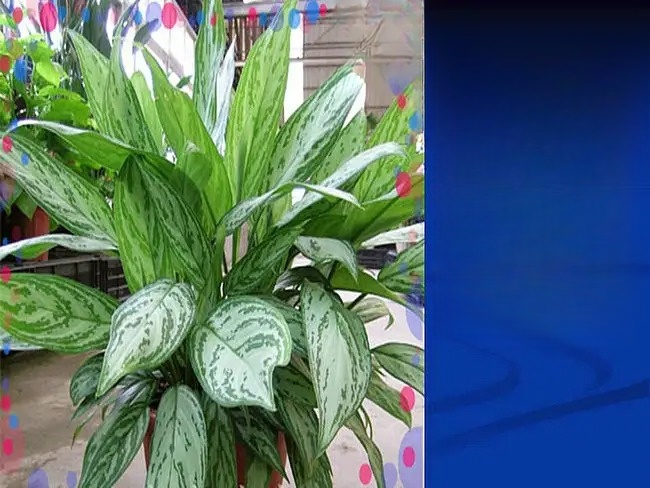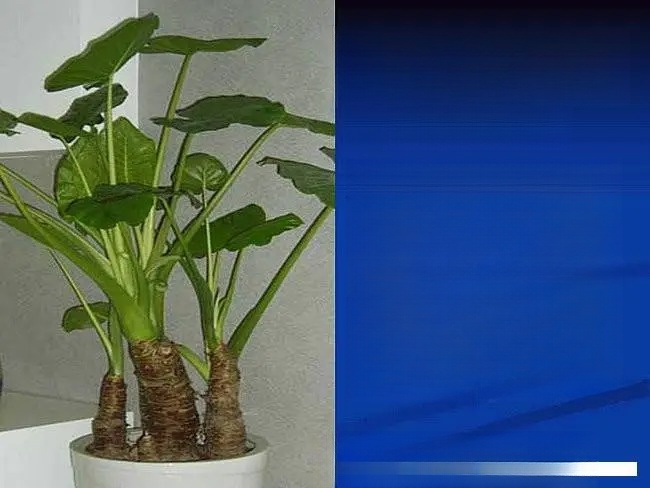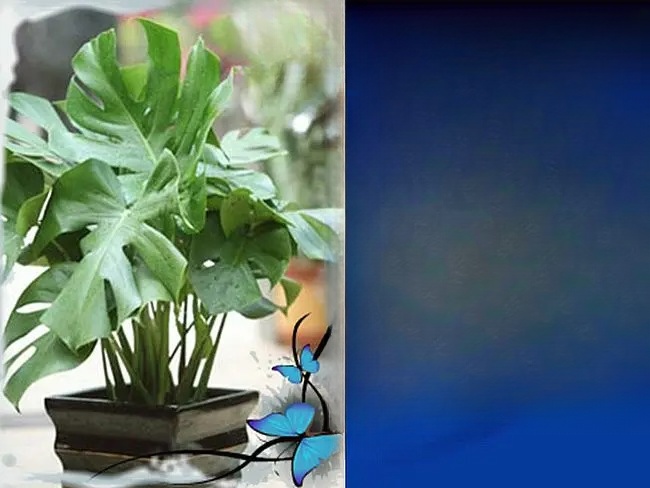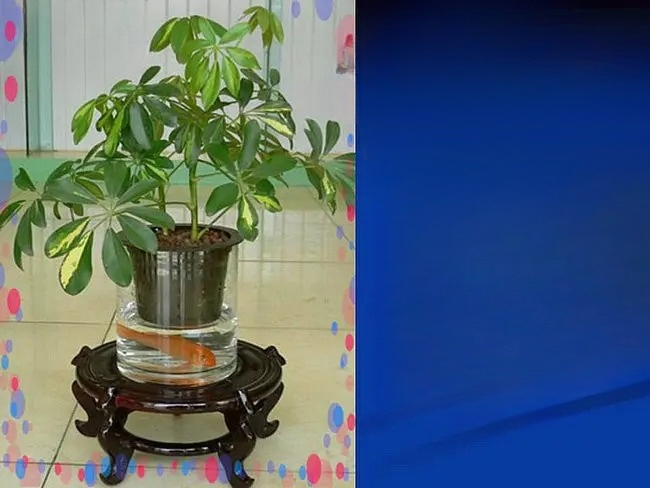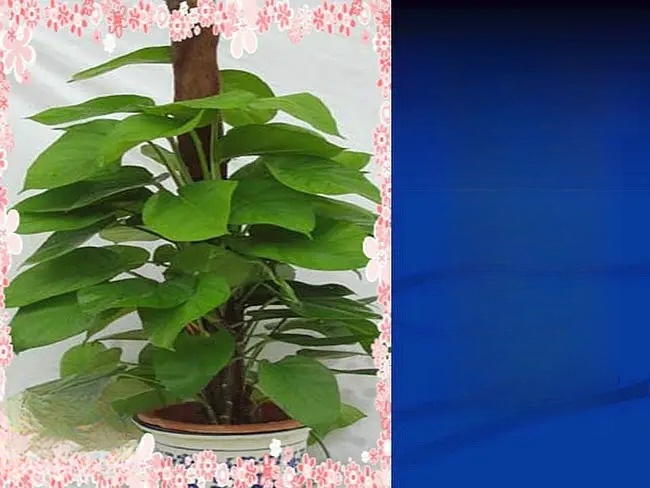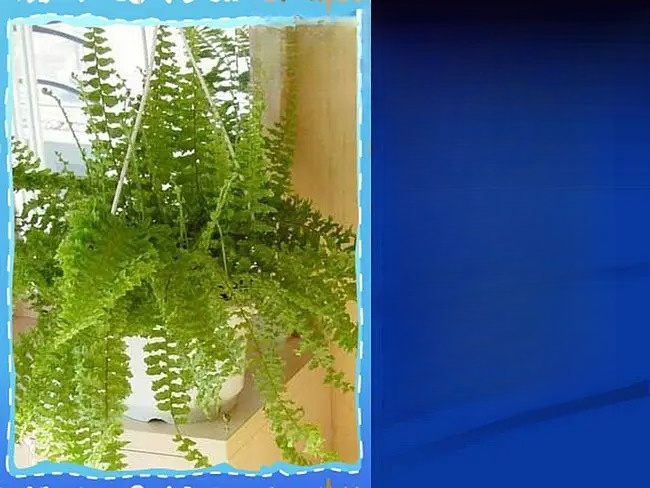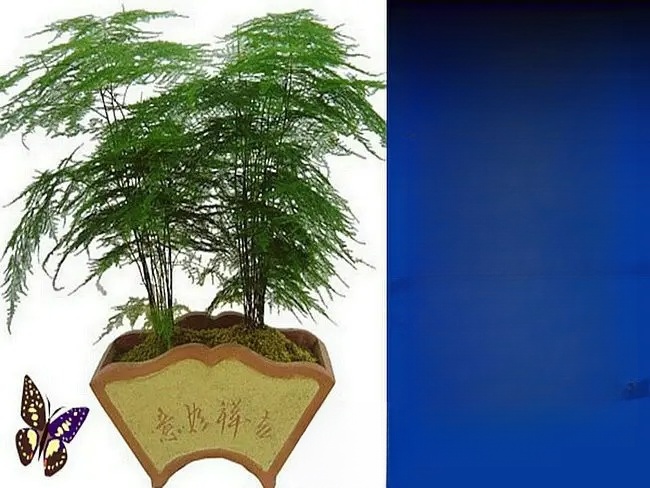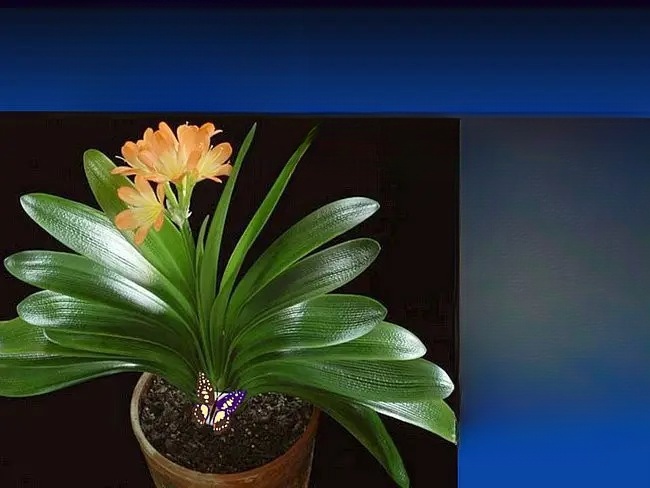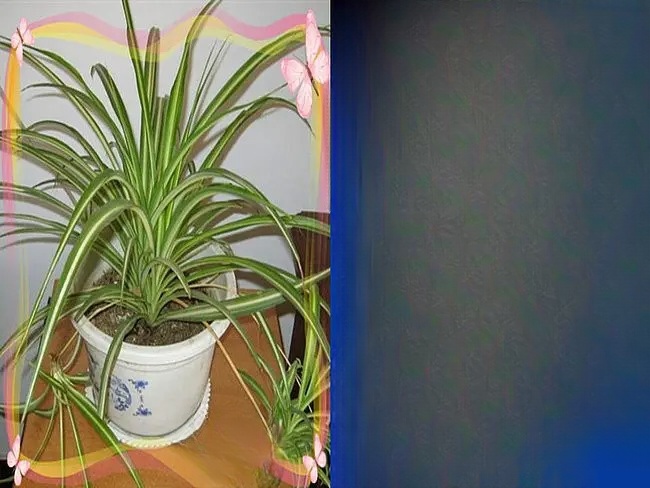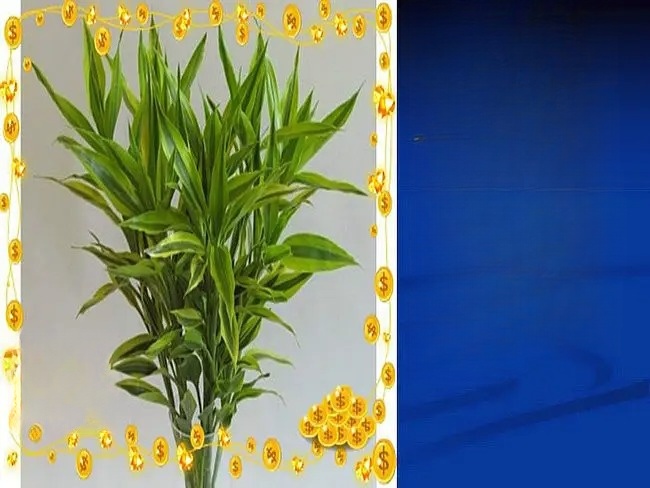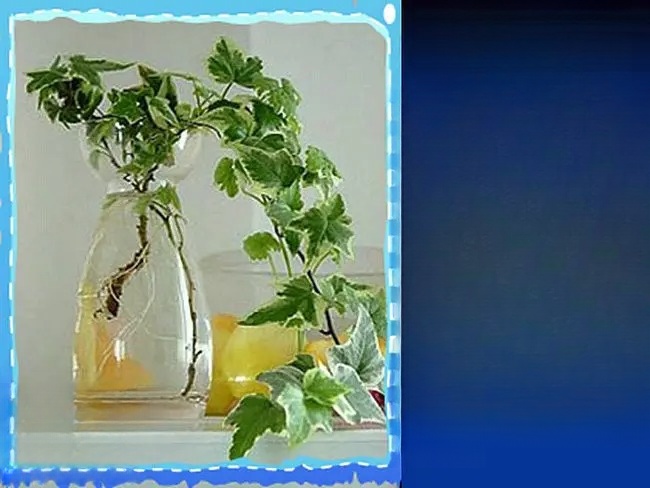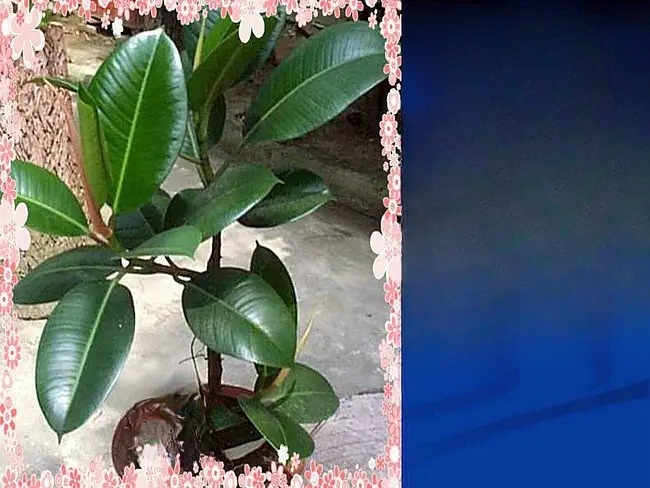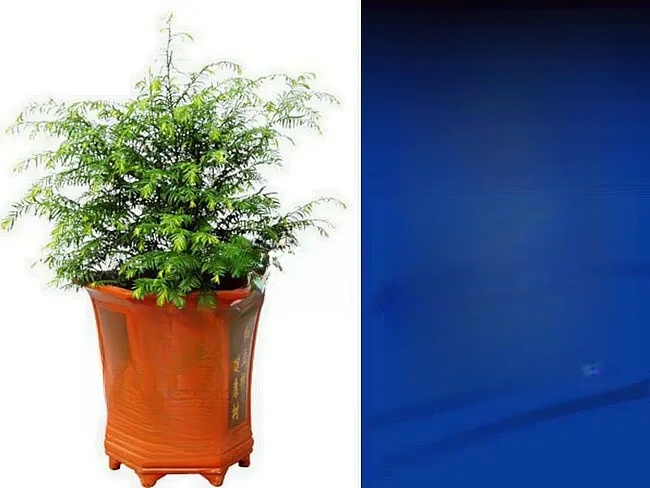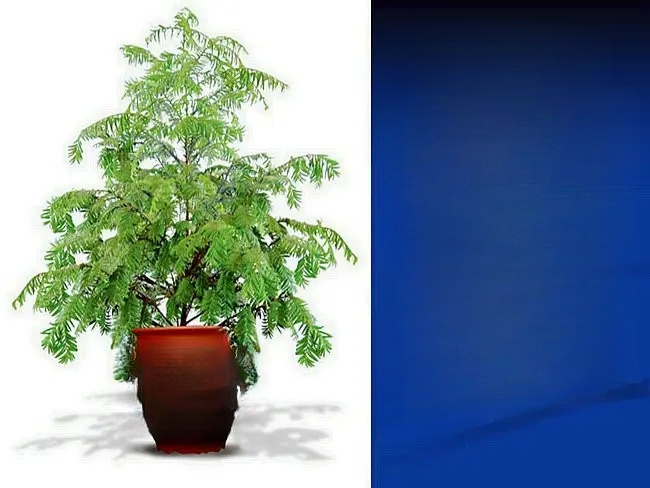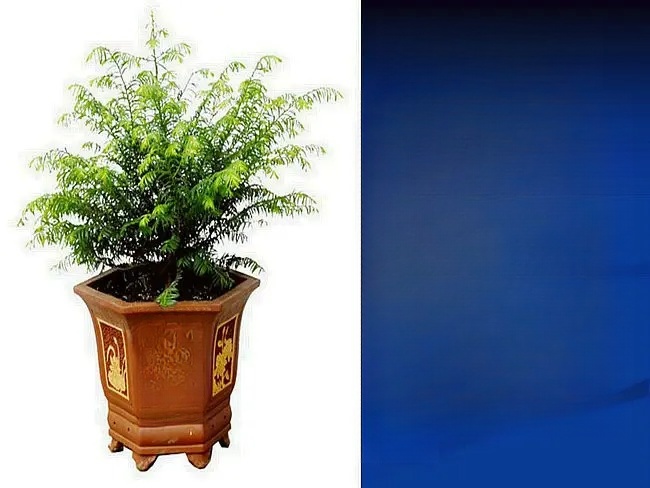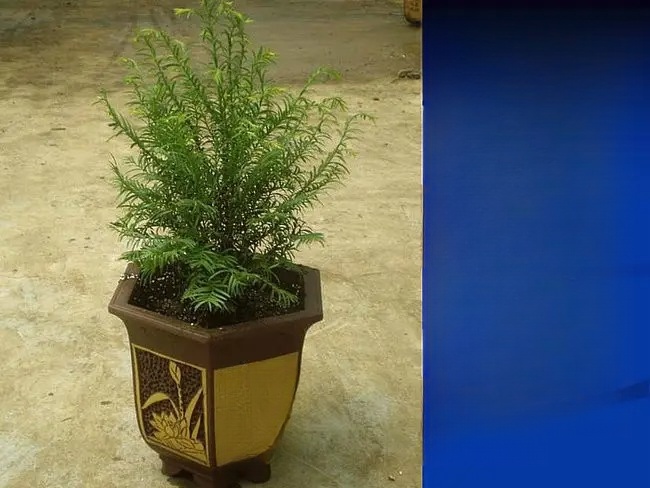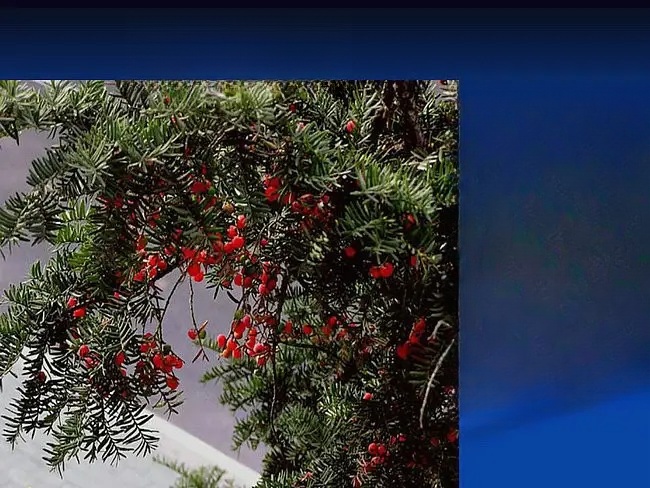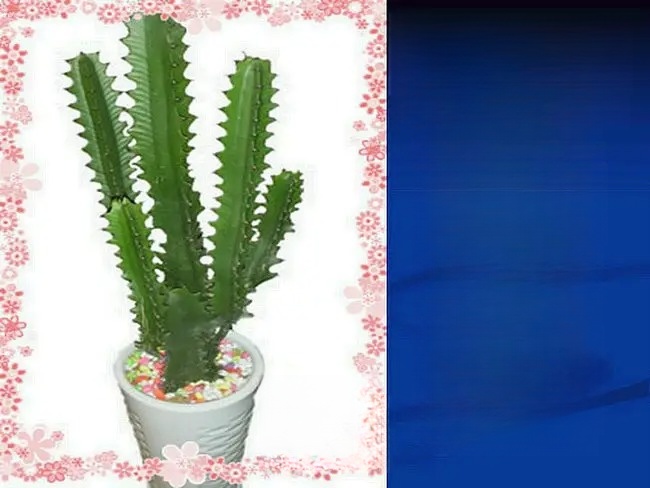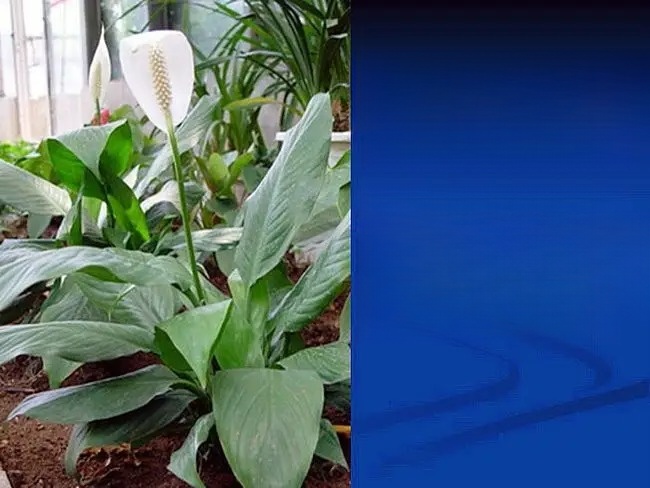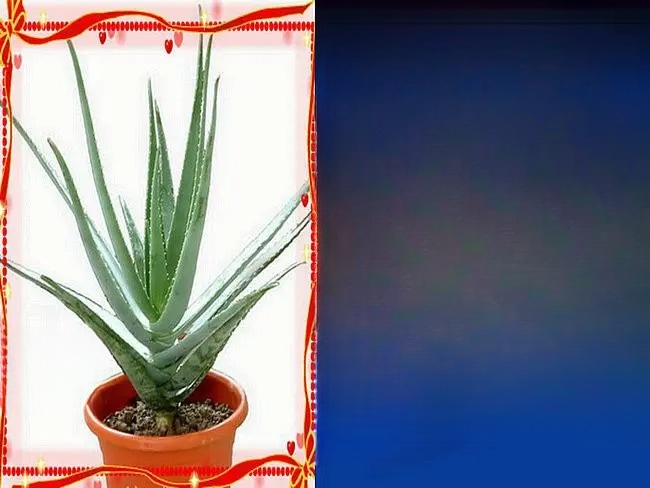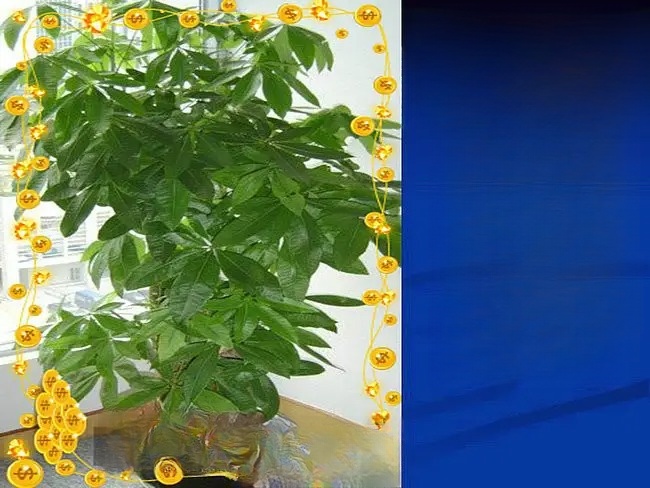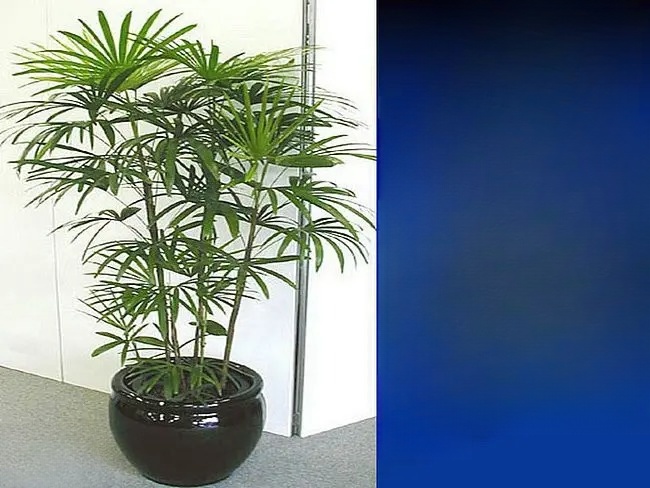50 Common Indoor Potted Green Plants
[Reprint] 50 Common Indoor Potted Green Plants
xiaojingli2008's blog - NetEase Blog 2015-07-07 10:37:38 | Category: Cultivation Technology
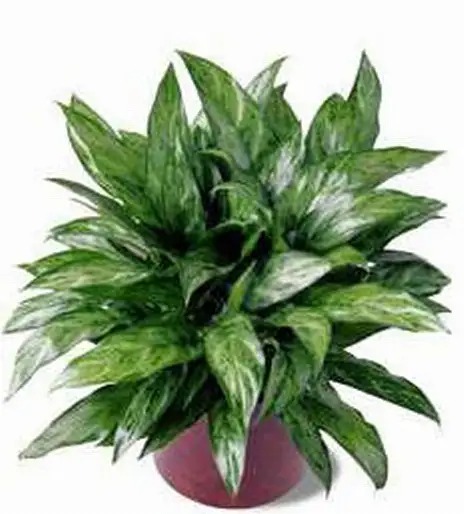
1. Plant name: Silver Emperor
Other names: Silver King Bright Silk Grass, Silver King Dieffenbachia, Silver King Rough Rib Grass.
Family: Araceae, Araceae.
Morphological characteristics: Perennial evergreen herb, very short stem, plant height 40-50 cm, densely clustered leaves, 20-25 cm long, 5-7 cm wide, lanceolate, dark green leaves, dense silver-gray spots on the leaf surface, gray-green back of the leaf. Petiole with gray-green spots, petiole base sheath-shaped clasping the stem. .
Cultivation value: Beautify study, living room, bedroom, can be placed for a long time.
Growth habits: It likes high temperature and high humidity environmental conditions, is both moisture-resistant and drought-resistant, likes scattered light, is relatively shade-tolerant, is not strict on soil, but likes fertile soil rich in humus.
Cultivation techniques: Mix equal amounts of leaf mold and river sand to make the culture soil for potting; apply liquid fertilizer once a month during the growing season; water sufficiently in summer and spray water on the leaves, gradually reduce the amount of watering in late autumn, do not water unless the potting soil is dry in winter, bring the plant indoors for the winter, and the indoor temperature must not be lower than 10℃; pay attention to ventilation when keeping it indoors; do not place it under the scorching sun in summer.
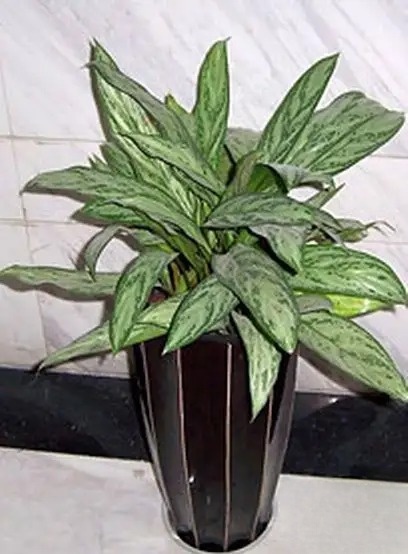
2. Plant name: Silver Queen
Other names: Silver Queen Dieffenbachia, Silver Queen Coarse Rib Grass, Silver Queen Bright Silk Grass. .
Family: Araceae, Araceae.
Morphological characteristics: It is a perennial herb. The plant is 30-40 cm tall, with an upright, unbranched stem and distinct internodes. The leaves are alternate, with long petioles and expanded sheath-like bases. The leaves are narrow and light green, with gray-green stripes on the leaf surface, covering a large area.
Cultivation value: Silver Queen is known for its unique air purification ability, which can remove nicotine and formaldehyde.
Growth habits: It likes warm and humid climate, is not cold-resistant, likes diffuse light, and is especially afraid of direct sunlight in summer; it is not cold-resistant, and insulation measures must be taken when the temperature drops to 10℃. After being frozen, the whole plant will rot.
Cultivation techniques: Loose peat soil and peat soil are the best for potting, and leaf mold and sandy loam can also be mixed. Store indoors in a place with strong light to make the leaves bright in color; the temperature should not be lower than 15℃ in winter; in the peak growing season in spring and autumn, watering should be sufficient, the potting soil should be kept moist, and the branches and leaves should be sprayed with clean water close to room temperature to prevent dry tips, but water should not be accumulated.
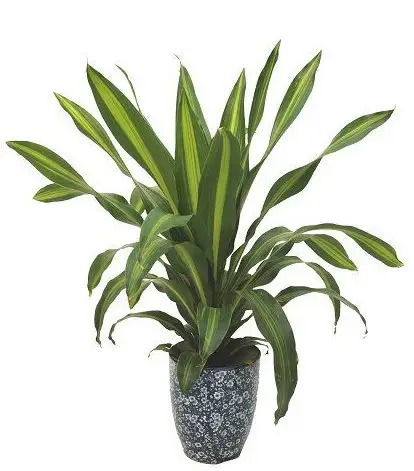
3. Plant name: Brazilian iron
Alias: Brazilian Millennium Wood, Golden Edge Dragon Blood Tree, Brazilian Wood.
Family: Liliaceae, Dracaena.
Morphological characteristics. An evergreen tree of the Liliaceae family, 50 cm to 150 cm high in potted plants, with branches; leaves clustered at the top of the stem, 40 cm to 90 cm long, 6 cm to 10 cm wide, curved in an arched shape, bright green and shiny; flowers are small and inconspicuous, and fragrant.
Cultivation value: As an indoor ornamental plant in the home or office, it looks very elegant when placed next to the sofa.
Growth habits: Likes high temperature. If the temperature is below 13℃, the plant will go dormant and stop growing. Likes loose, well-drained soil. Use leaf mold or peat soil for potting.
Cultivation techniques: When placing the Brazilian iron indoors, it should be placed in a place with sufficient light; if the light is too weak, the stripes on the leaves will turn green, and the leaves at the base will turn yellow, losing their ornamental value. During the cultivation period, the water quality should be kept clean, and water should be watered 1 to 2 times a week. Too much water should not be used to prevent the trunk from rotting. In the summer when the temperature is high, the spray method can be used to increase the air humidity, and water can be sprayed on the leaves to keep them moist.
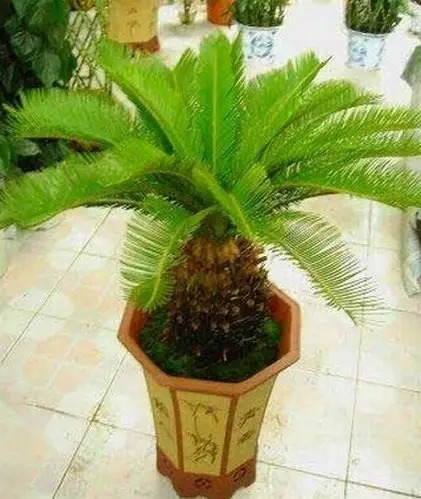
4. Plant name: Cycas revoluta
Other names: iron tree, phoenix tail banana, phoenix tail pine, fire-avoiding banana:
Family: Cycadaceae Cycas:
Morphological characteristics: an evergreen palm-like woody plant; the stem is cylindrical and unbranched; the stem is densely covered with persistent leaf bases and leaf scars, and is scaly; the leaves are spirally arranged, growing from the top of the stem, and there are two types of leaves: nutrient leaves and scale leaves. The nutrient leaves are pinnate and large, while the scale leaves are short and small; the leaflets are linear, curled inward when first born, then spread obliquely upward, slightly "V" shaped, with the edges significantly curled downward, thick leathery, hard, and shiny.
Cultivation value: Cycad has a peculiar shape, verdant leaves, and a strong tropical charm. It is suitable to use multiple trees and rocks to configure a scenic spot.
Growth habits: Likes light, slightly tolerant to partial shade. Likes warmth, not very cold-resistant, likes fertile, moist and slightly acidic soil, but can also tolerate drought. Slow growth, plants over 10 years old can bloom.
Cultivation techniques: Water once every half a month in spring, and in the growing season from late spring to summer, allow it to fully receive sunlight; water when it is dry, keep the soil moist, and spray water on the leaves in the morning and evening; apply a lighter liquid fertilizer every ten days. Gradually control the frequency and amount of watering after autumn; fully receive direct sunlight; spray water appropriately when the temperature is high. In winter, control the amount and frequency of watering, and water about once every half a month.
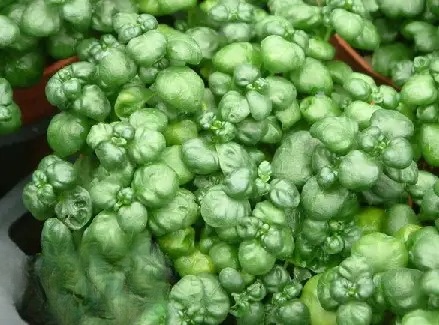
5. Plant name: Black Beauty
Other names: Spring grass, loose bed
Family: Acanthaceae
Morphological characteristics: Perennial herb, low plant, only 5 to 10 cm high. Leaves are opposite, heart-shaped or broadly ovate, slightly wrinkled and curly, resembling black people's hair, hence the name, plant in a clump, dense branches and leaves not easily messy.
Cultivation value: Black Beauty is also an indoor air purifier that can increase the oxygen ion content and absorb a certain amount of harmful gases such as formaldehyde, sulfur dioxide and hydrogen sulfide in the air.
Growth habits: It likes high temperature and humidity, and the suitable temperature for growth is about 22-30℃.
Cultivation techniques: Fertile sandy loam is the best soil for cultivation, with good drainage and sunshine, and a little shade is also fine; fertilize with oil cake or nitrogen, phosphorus, and potassium once a month, and more nitrogen fertilizer can promote beautiful leaf color. When the cold current invades and the temperature drops below 15℃, it is necessary to prevent cold damage and avoid frostbite of leaves due to stagnant water overnight.
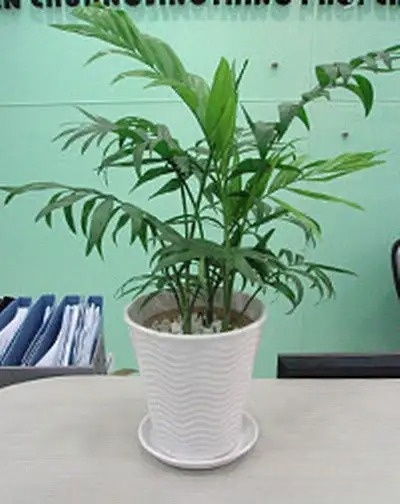
6. Plant name: Miniature Coconut
Other names: dwarf coconut, pocket palm, dwarf palm
Family: Palm family, genus:
Morphological characteristics: When the miniature coconut is potted, the plant height does not exceed 1 meter. Its stem is slender and upright, unbranched, dark green, with irregular ring patterns. The leaves grow from the top of the stem, are pinnate compound leaves, fully divided, with broad lanceolate lobes, and 20 to 40 pinnate leaflets, sickle-shaped, dark green, and shiny. :
Cultivation value: It can purify benzene, trichloroethylene and formaldehyde in the air at the same time, and is a "high-efficiency air purifier" among plants.
Growth habits: like warm, humid and semi-shady environment, not cold-resistant, like weak light, avoid strong direct sunlight; relatively drought-resistant, also resistant to water and humidity, like well-drained, fertile, moist soil. The suitable growth temperature is 20-30℃, it enters dormancy at 13℃, and the lowest temperature for wintering is 3℃.
Cultivation techniques: Generally, apply liquid fertilizer 1-2 times a month during the growing season, and apply little or no fertilizer in late autumn and winter; the principle of watering is to keep the plant dry rather than wet, and the potting soil can be kept moist; when the air is dry in summer and autumn, spray the plant with water frequently, and reduce the amount of watering appropriately in winter to facilitate overwintering.
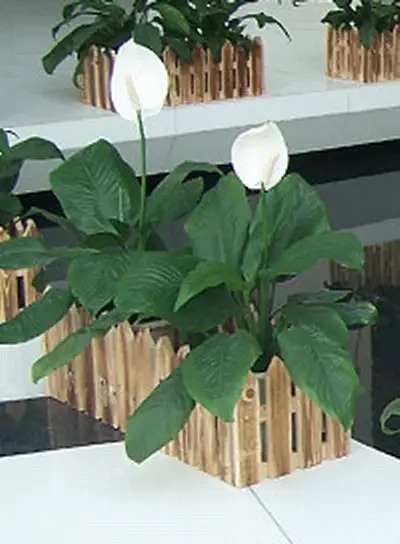
7. Plant name: White Palm
Other names: Peace taro, Spathiphyllum spatholobi, Peace taro:
Family: Araceae, Araceae
Morphological characteristics: Perennial evergreen herbaceous foliage plant. Plant height 40-60 cm, with short rhizomes, mostly in clusters. Leaves are oblong or nearly lanceolate, gradually pointed at both ends, and wedge-shaped at the base. The flowers are spathes, slightly fragrant, leaf-shaped, and resemble palms, hence the name white palm. :
Cultivation value: Anthurium can inhibit waste gases exhaled by the human body such as ammonia and acetone. It can also filter benzene, trichloroethylene and formaldehyde in the air.
Growth habits: like warm, humid, semi-shady environment, avoid strong direct sunlight. Not cold-resistant, the suitable growth temperature is 20-28℃, and the wintering temperature is above 10℃.
Cultivation techniques: Spathiphyllum potted plants require loose soil with good drainage and ventilation. Heavy clay soil is not allowed. Liquid fertilizer should be applied every 1 to 2 weeks during the growing season. At the same time, sufficient water should be provided to keep the soil moist. During the high temperature period, water should be sprayed on the leaves to increase the air humidity. In late autumn and winter, watering should be reduced to keep the soil slightly moist. In winter, attention should be paid to cold protection and heat preservation, while keeping the soil moist.
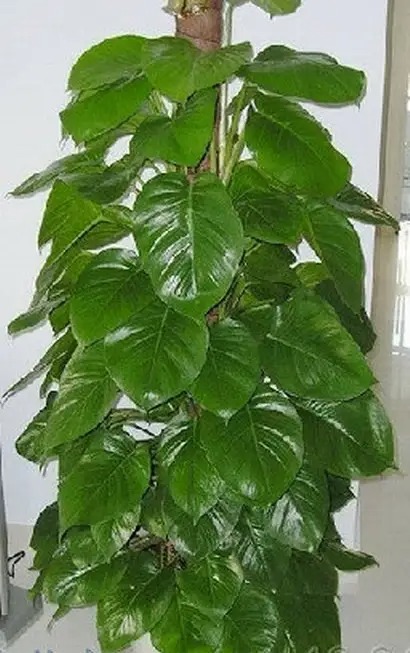
Family: Araceae, Chlorophytum
Morphological characteristics: The vine of Pothos is several meters long. It often grows on rocks and tree trunks in rainforests in tropical areas. It has aerial roots between nodes. As it grows older, the stem thickens and the leaves also become larger and larger, and it can grow into a huge vine. A few leaves may also be slightly yellow or white.
Cultivation value: In addition to its high ornamental value, the green ivy can also effectively absorb and remove pollutants such as formaldehyde, benzene, trichloroethylene, etc. in indoor air, making it a natural "air purifier."
Growth habits: It likes warm, humid and semi-shady environment, and requires loose, fertile and well-drained soil; it is sensitive to light and avoids direct sunlight; it can tolerate a relatively dry environment and still grows well when the air humidity is 40% to 50%.
Cultivation techniques: The pot soil should be loose, fertile, and rich in organic matter; the green radish requires a high temperature and strong scattered light environment to grow; water moderately, keep the pot soil dry, and spray water on the leaves and backs frequently. In summer and autumn, spray water on the leaves every morning, noon, and evening to increase humidity; apply thin liquid fertilizer once every 10 to 1 day. The plant has many branches and should be properly pruned.
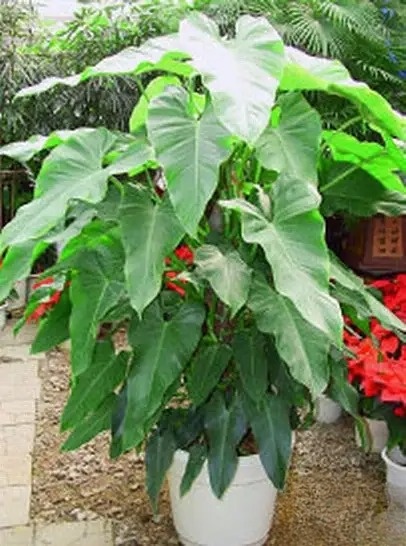
9. Plant name: Emerald
Other names: Long-heart-leaved Philodendron, Emerald Philodendron
Family: Araceae Philodendron
Morphological characteristics: Emerald Philodendron is a creeping species with a thick stem and aerial roots on the nodes; the leaves are long heart-shaped, 25 to 35 cm long and 12 to 18 cm wide, without a sharp tip, deeply heart-shaped at the base, green, entire, and shiny. The young shoots and leaf sheaths are both green.
Cultivation value: It is often cultivated in large and medium-sized plants and displayed in halls, conference rooms, offices, etc., which is very spectacular.
Growth habits: It likes warm, humid and semi-shady environment. The suitable temperature for growth is 20-28℃, and the wintering temperature is 5℃.
Cultivation techniques: Generally, water once a day in spring and summer, and once every 3 to 5 days in autumn; in winter, watering should be reduced, but the pot soil should not be completely dry. Pay attention to topdressing during the growing season, generally 1 to 2 times a month; in late autumn and winter, when growth slows or stops, stop fertilizing. It likes bright light, but avoids strong sunlight.
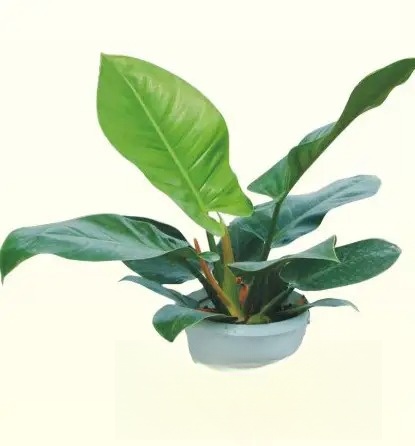
10. Plant name: Green Emperor
Other names: Green Emperor Philodendron, Emperor
Family: Araceae, Philodendron
Morphological characteristics: The internodes of the stem of Green Emperor are short, with a spacing of about 1 to 2 cm. There are often adventitious aerial roots between the nodes. The stem can be up to 2 to 4 cm thick, light brown, and poorly upright. The leaves are large, clustered in a rosette shape, gradually changing from yellow-green to green or dark green, and shiny.
Cultivation value: It has environmental protection function, can absorb dust and a large amount of carbon dioxide in the air, release oxygen, make the indoor air fresh, and increase the oxygen ion content.
Growth habits: It likes high humidity and high temperature and is best planted in slightly acidic soil.
Cultivation technology: When cultivating Green Emperor, choose slightly acidic peat soil or soil with high humus and add a small amount of sand or perlite; watering should be done thoroughly, and flexibly controlled according to the season and temperature. In principle, keep the potting soil moist; the suitable growth temperature of Green Emperor is 20-30℃, the air humidity is not less than 70%, and the temperature in autumn should be kept above 14℃.
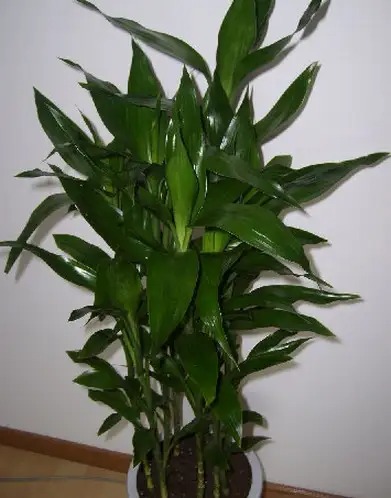
11. Plant name: Lucky bamboo
Other names: Longevity bamboo, Longevity bamboo with flower, Fortune bamboo, Tower of wealth, Bamboo tower, Tower bamboo
Family: Agavaceae, Dracaena
Morphological characteristics: evergreen subshrub; plant height more than 1m, slender, upright with branches on the upper part; rhizomes running horizontally, tubercular; leaves alternate or nearly opposite, papery, long lanceolate, with obvious 3 to 7 main veins, short petioles, dark green; umbels with 3 to 10 flowers growing in leaf axils or opposite the upper leaves, 6 perianths, bell-shaped corolla, purple; berries nearly globose, black.
Cultivation value: Mainly used as potted ornamental plant with high ornamental value.
Growth habits: It likes shade, humidity and high temperature. It is shade-tolerant and waterlogged-tolerant, has strong fertilizer and cold resistance.
Cultivation techniques: Grow lucky bamboo in a vase with water, and change the water every 3 to 4 days. It is not advisable to change the water after it takes root, and water can only be added in time after the water evaporates. Before adding water, store it in a container for one day, and keep the water clean and fresh. Do not use dirty water, hard water or water mixed with oil, otherwise the roots will easily rot. Do not place lucky bamboo next to a TV or in places where air conditioners or electric fans often blow, so as to prevent the tips and edges of the leaves from drying out.
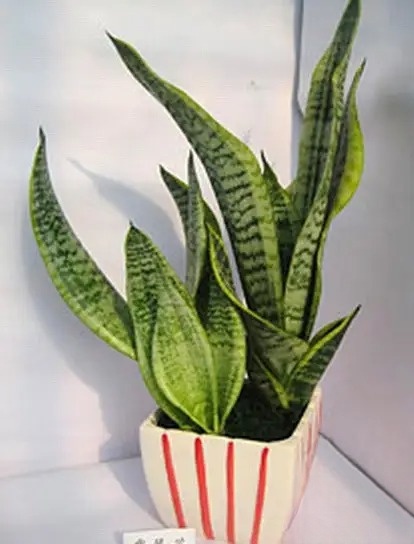
12. Plant name: Tiger tail orchid
Other names: Tiger skin orchid, Jinlan, Golden-edged tiger tail orchid, Silver-veined tiger tail orchid
Family: Agavaceae, Sansevieria
Morphological characteristics: The underground stem is branchless, the leaves grow in clusters, the lower part is tubular, the middle and upper parts are flat, the sword-shaped leaves are rigidly upright, the plant height is 50 cm to 70 cm, the leaf width is 3 cm to 5 cm, the leaf margin is entire, the surface is milky white, light yellow, dark green, and has horizontal stripes.
Cultivation value: Placing a pot of Sansevieria in the bathroom can absorb moisture and kill bacteria.
Growth habits: Drought-resistant, moisture-resistant, and shade-tolerant, and can adapt to various harsh environments.
Cultivation techniques: Watering should be moderate, not too wet; from spring to autumn, it grows vigorously, so it should be watered fully; during the winter dormancy period, watering should be controlled to keep the soil dry, and water should not be poured into the leaf clusters; water accumulation should be avoided to avoid rot and the leaves below being broken; fertilization should not be excessive. During the peak growth period, fertilizer can be applied 1 to 2 times a month, and the amount of fertilizer should be small.
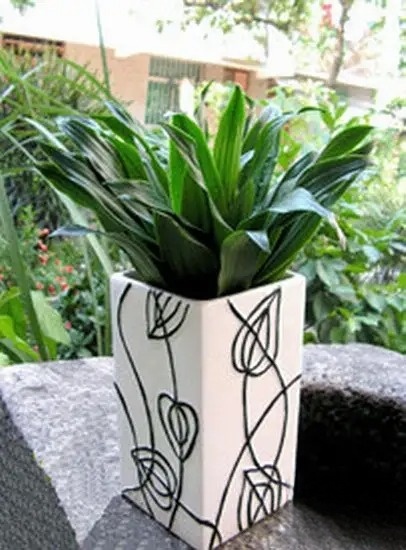
13. Plant name: Heliotropium
Other names: Dense-leaved Dracaena, Dense Green Dracaena, Apollo Millennium Tree, Dense-leaved Dracaena
Family: Agavaceae, Dracaena
Morphological characteristics: small evergreen tree, dwarf species. Stem erect, unbranched, leaves densely arranged in whorls, oblong lanceolate, 10-15 cm long, 2-4 cm wide, dark green.
Cultivation value: The Sun God plant is compact and small, with fine green leaves, making it a treasure for indoor greening decoration.
Growth habits: likes high temperature, high humidity and semi-shady environment, drought-resistant, strong shade-tolerant, suitable growth temperature is 22-28℃. Slow growth. Likes well-drained, humus-rich soil.
Cultivation techniques: It should be placed in a bright place in spring and autumn, and be sprayed with water when the air is dry to ensure suitable air humidity for growth. It should not be exposed to direct sunlight. During the high temperature period in summer, if the air is too dry, it will cause the tips of the leaves to burn, so water should be sprayed on the leaves frequently. Water less in winter, at most once a week during the growing season. During the winter dormancy period, water once every 10 to 15 days.
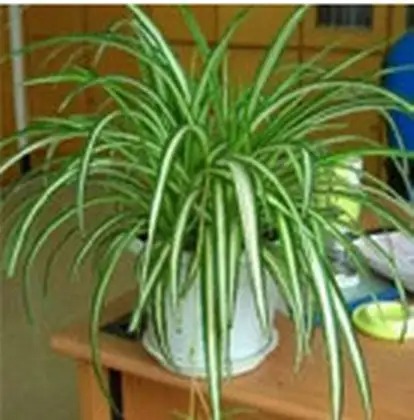
14. Plant name: Chlorophytum comosum
Other names: potted grass, hook orchid, osmanthus orchid, hanging bamboo orchid, crane orchid
Family: Liliaceae, Chlorophytum
Morphological characteristics: Chlorophytum is a perennial herb with clustered cylindrical hypertrophic fibrous roots and rhizomes; the edges of the green leaves are inlaid with yellow and white stripes on both sides or in the middle; there are flowers, which are white and bloom in spring and summer, and can also bloom indoors in winter.
Cultivation value: Chlorophytum has the function of absorbing toxic gases and plays a role in purifying the air.
Growth habits: It likes warm, humid and semi-shady environment. It has strong adaptability, is relatively drought-resistant, not very cold-resistant; it can also tolerate weak light.
Cultivation techniques: The potting soil should always be kept moist. During the period of vigorous growth, the leaves should be sprayed with water 1 to 2 times a day to increase the air humidity. In summer, water should be poured once in the morning and evening, and once a day in spring and autumn. In winter, moisture is prohibited. Water can be poured every 4 to 5 days, and the amount of watering should not be too much. Apply liquid fertilizer every two weeks during the growing season. Chlorophytum likes semi-shady environment and can be cultivated in a bright indoor environment all year round.
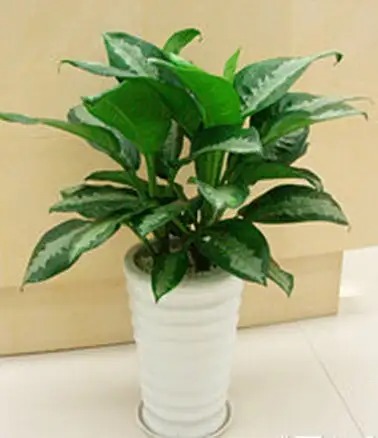
15. Plant name: Queen Elysia
Other name: Snowy rib grass
Family: Araceae, Dieffenbachia
Morphological characteristics: The plant is upright, with lanceolate, leathery, sharp-pointed, dark green leaves; there are large silver-gray stripes on both sides of the midrib, and the leaf margins and midrib are dark green; it has strong growth potential and is easy to branch.
Cultivation value: purify formaldehyde and remove volatile organic compounds
Growth habits: The optimum growth temperature is 18-30℃, it likes moisture and is afraid of dryness, it tolerates shade and is afraid of strong light.
Cultivation techniques: The soil should be fertile, loose, and acidic loam with strong water retention. It likes moisture and is afraid of dryness. It needs sufficient water during the growth period of stems and leaves. In addition to normal watering, spray water every morning and evening. Keep the air humidity at 60% to 70% in summer and around 40% in winter. However, when the room temperature is low in winter, the amount of watering and spraying should be reduced, otherwise the pot soil will be too wet, the roots will easily rot, and the leaves will turn yellow and wither.
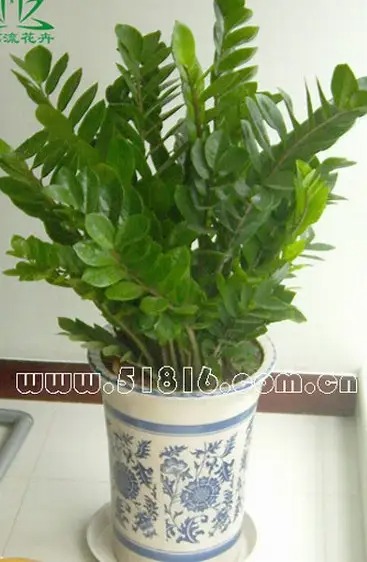
Other names: Gold coin tree, snow iron taro, Zemi leaf Arisaema, Dragon and Phoenix wood
Family: Araceae, Alocasia
Morphological characteristics: There is no main stem in the aboveground part, and adventitious buds sprout from the tubers to form large compound leaves. The leaflets are fleshy with short petioles, firm and dark green; the underground part is a fat tuber; the leaves are rooted, and the pinnate compound leaves grow from the top of the tuber. The leaf axis is strong, and the leaflets are opposite or nearly opposite on the leaf axis. The base of the petiole is swollen and woody; each compound leaf has 6 to 10 pairs of leaflets, with a lifespan of more than 2 to 3 years, and is constantly renewed by new leaves.
Cultivation value: Money tree is a very popular large indoor bonsai plant.
Growth habits: It likes warm, slightly dry, semi-shady environment with small annual temperature changes. It is relatively drought-resistant, but afraid of cold, strong sunlight and waterlogging.
Cultivation techniques: It is better to keep the pot soil slightly moist and slightly dry. In winter, pay attention to spraying water on the leaves and the surrounding environment to make the relative air humidity reach more than 50%. After the Mid-Autumn Festival, watering should be reduced, or spraying water instead of watering; in winter, special attention should be paid to the pot soil not being too moist, and it is better to keep it slightly dry. Otherwise, under low temperature conditions, excessive moisture in the pot soil is more likely to cause plant root rot, or even death of the whole plant.
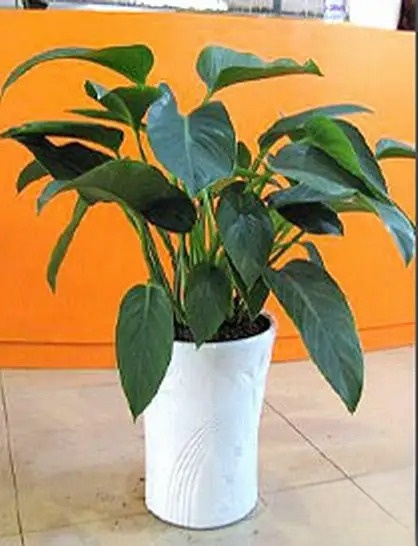
17. Plant name: Golden Diamond
Other names: Golden Diamond Philodendron, Spring Feather, Camptotheca acuminata
Family: Araceae Philodendron
Morphological characteristics: palm-shaped, thick, deeply pinnate, shiny; petiole long and strong, aerial roots extremely developed and strong, hanging down in disorder. Leaves evenly matched, moderately stretched, thick and emerald green, with a rigid and bright leaf surface, each leaf has a lifespan of up to 30 months.
Growth habits: likes warm, humid and semi-shady environment, afraid of severe cold and strong light, suitable for growing in sandy loam rich in humus and with good drainage.
Cultivation techniques: Watering should be done when the topsoil is slightly dry, not too wet; if the pot soil is wet for a long time, the roots will rot; it should be placed in a semi-shaded place during the growing period, and avoid direct sunlight in summer; it should be placed near the window when growing indoors. Watering should always keep the soil moist, and when it is dry, the plant should be sprayed with water to wet and cool it down. May to September is the peak growing season, and fertilizer and water should be applied 1 to 2 times a month, but not too much.
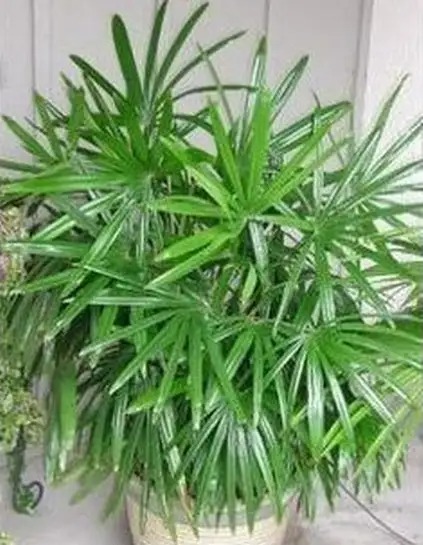
18. Plant name: Bamboo
Other names: Phoenix tail bamboo, rice bamboo, tendon bamboo, Penglai bamboo
Family: Poaceae, Bamboo
Morphological characteristics: The culms are densely clustered, short and hollow; the culms are 1 to 3 meters high, 0.5 to 1.0 cm in diameter, with drooping leafy branches, each branch has 9 to 13 leaves, the leaves are small, linear-lanceolate to lanceolate, 3.3 to 6.5 cm long, 0.4 to 0.7 cm wide. The plants grow in clusters, bent and drooping.
Cultivation value: Often used for potted viewing, to embellish small courtyards and living rooms, and also often used to make bonsai or as low hedge material.
Growth habits: likes warm, humid and semi-shady environment, has poor cold resistance, is not resistant to strong sunlight, and is afraid of waterlogging.
Cultivation techniques: It has slightly poor cold resistance and should be moved indoors to keep warm in winter; it should not be exposed to the sun in summer and should be placed under a shade shed for maintenance; it should be watered frequently during the vigorous growth period to keep the soil moist, but avoid water accumulation; water it once every 1 to 2 days on average in summer and less in winter, but make sure the soil is moist to prevent "dry freeze"; fertilizer should be applied 2 to 3 times during the growing period each year; at the same time, branches that grow too long should be pruned short.

19. Plant name: Areca palm
Other names: yellow coconut, purple sunflower
Family: Palmaceae, Areca palm
Morphological characteristics: evergreen shrubs or small trees. Stems are smooth, yellow-green, without burrs, covered with wax powder when young, with obvious leaf scars in the shape of rings. The leaves are smooth and slender, pinnate compound leaves, completely divided, 40 to 150 cm long, with slightly curved petioles and soft tips; the lobes are linear-lanceolate, asymmetrical on both sides, the middle lobe is about 50 cm long, the top lobe is only 10 cm, the ends are long and gradually pointed, often with 2 short lobes, and the main vein on the back is raised.
Cultivation value: Potted Areca palm is a high-end potted foliage plant for decorating living rooms, dining rooms, conference rooms, family rooms, study rooms, bedrooms or balconies. It can also be used as medicine, mainly treating hematemesis, hemoptysis, bloody stools, and metrorrhagia.
Growth habits: It likes warm, humid, semi-shady and well-ventilated environment. It is not cold-resistant, but is relatively shade-tolerant and afraid of the scorching sun.
Cultivation techniques: Watering should follow the principle of "dry through, wet through" according to the season. In dry and hot seasons, water more appropriately, and in low temperature and rainy seasons, water less. Liquid fertilizer can be applied all year round. In summer, nitrogen-containing organic fertilizer can be applied appropriately, and in winter, organic fertilizer such as sesame paste residue can be applied. Rotate the flower pot regularly, trim the lower and internal dead leaves frequently, and pay attention to trimming the crown shape. In winter, the indoor temperature must be kept above 10℃.
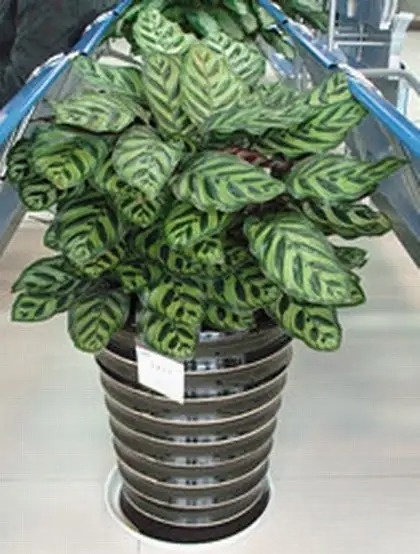
Other names: Blue banana, five-color kudzu vine
Family: Marantaceae, Maranthus
Morphological characteristics: Perennial evergreen herb. 30-60 cm tall, leaves 15-20 cm long, 5-10 cm wide, ovate-elliptical, thin, leathery, petiole purple-red. The green leaves have a faint metallic luster and are bright and colorful. Feathery, dark green, oblong velvety patches are distributed on both sides of the midrib, arranged alternately on the left and right. The back of the leaves is purple-red.
Cultivation value: It can remove ammonia pollution in the air (it can remove 0.86mg of formaldehyde and 2.19mg of ammonia within 10 square meters).
Growth habits: It likes semi-shade, cannot tolerate direct sunlight, and adapts to growing in a warm and humid environment.
Cultivation techniques: The potted peacock arrowroot should be planted in loose, fertile, well-drained, slightly acidic loam rich in humus. It should be given sufficient water during the growing period. In addition to keeping the pot soil moist in summer and autumn, it is also necessary to spray water on the leaves frequently to cool and moisturize. Avoid dry air and dry pot soil, but do not allow water to accumulate. After late autumn, the water should be controlled to help it resist the cold and survive the winter.
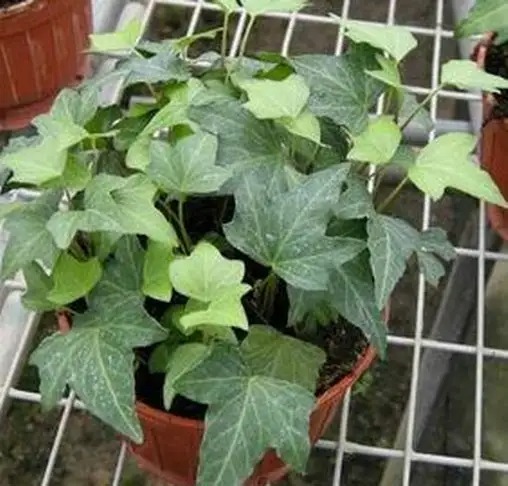
21. Plant name: Ivy
Other names: Earth drum vine, sky-drilling wind, triangular wind, creeper, scattered bone wind, maple pear vine
Family: Araliaceae, Hedera
Morphological characteristics: The stem has roots to climb other things, the young leaves and inflorescences are covered with star-shaped scales, the leaves are petiolate and thick, and the leaves of the grape branches are slightly triangular and palm-shaped. Its fruits, seeds and leaves are all poisonous.
Cultivation value: It can purify indoor air, absorb harmful gases such as benzene and formaldehyde, and can also effectively resist carcinogens in nicotine.
Growth habits: It likes warm and shady environment, avoids direct sunlight, but likes sufficient light. It is relatively cold-resistant and has strong resistance. It is not strict on soil and water, and neutral and slightly acidic are best.
Cultivation technology: Ivy cultivation and management are simple and extensive, but it needs to be planted in a place with moist soil and good air circulation; potted plants can be tied with various brackets and pulled to shape them. They can be maintained under a shade shed in summer and placed in a greenhouse for wintering. The indoor air humidity should be maintained and not too dry, but the potting soil should not be too wet.

22. Plant name: Clivia
Other names: Clivia miniata, Lycoris radiata, Lycoris radiata, Damulan
Family: Amaryllis, Clivia
Morphological characteristics: Clivia is a perennial herb with fleshy fibrous roots and pseudobulbs at the base of the leaves. The leaves are sword-shaped and can be up to 45 cm long, arranged alternately, with entire margins. The umbels are terminal, with 7 to 30 small flowers in each inflorescence, and up to 40 or more. The small flowers have stalks and are arranged in an umbel shape at the top of the flower. The flowers are funnel-shaped, upright, and yellow or orange. It can bloom all year round, mainly in spring and summer.
Cultivation value: Clivia has high ornamental value, and also has the function of purifying the air and has medicinal value.
Growth habits: avoid strong light, it is a semi-shade plant, likes coolness and avoids high temperature. It likes fertile, well-drained soil and moisture, and avoids dry environment.
Cultivation techniques: Clivia is suitable for soil rich in humus. Generally, water it once a day in spring; water it twice a day on sunny days in summer, water it once every other day in autumn, and water it once a week or less in winter.
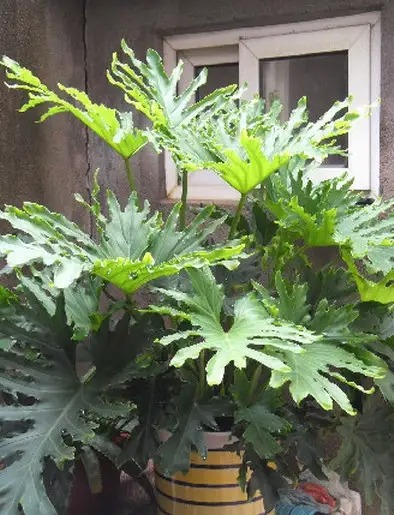
23. Plant name: Spring Feather
Other names: Spring taro, feather-cracked philodendron, philodendron, little angel philodendron
Family: Araceae, Araceae
Morphological characteristics: Perennial evergreen herbaceous foliage plant; the stem is very short, and the leaves extend from the top of the stem to all sides, arranged closely and neatly, in a clustered shape. The leaves are huge, with thick and deep pinnate lobes, dark green and shiny. The stem is upright, woody, and has many aerial roots; the plant is tall and can reach more than 1.5 meters. The leaves are clustered and born at the end of the stem; the leaves are broad heart-shaped, and the whole leaf is deeply pinnate and palm-shaped.
Cultivation value: The leaves of the feather-lobed philodendron are peculiar and very shade-tolerant, making them suitable for indoor hall furnishings, especially for decorating music teahouses and hotel lounges.
Growth habits: Spring fern likes high temperature and humid environment, has no strict requirements on light, is not cold-resistant, but tolerates darkness. It can be grown in pots in places where the light indoors is not too weak. It likes fertile, loose, well-drained slightly acidic soil, and the winter temperature should not be lower than 5°C.
Cultivation techniques: Apply some light fertilizer during the growing season, but not too much; spray water on the leaves more often, and control watering appropriately in winter; avoid direct sunlight during the high temperatures in summer; water thoroughly twice a day in summer, spray water on the leaves frequently, clean the leaves, and keep them fresh and moist.
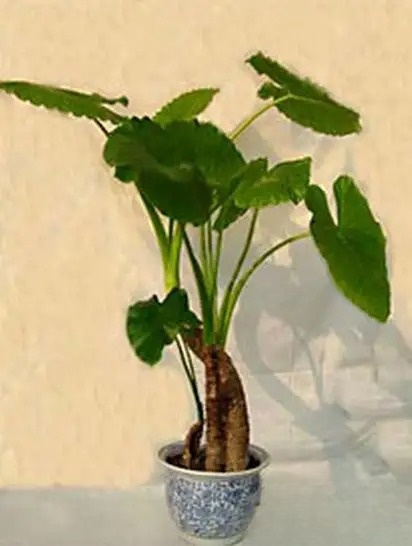
24. Plant name: Dripping Guanyin
Other names: dripping lotus, Buddha's hand lotus
Family: Araceae, Alocasia
Morphological characteristics: Under warm and humid conditions with sufficient soil moisture, water will drip downward from the tip or edge of the leaves; and the flowers that bloom resemble Guanyin, so it is called Dripping Guanyin.
Cultivation value: The white juice in the stem of the weeping angel is poisonous, and the dripping water is also poisonous, but it can purify the air.
Growth habits: Perennial evergreen herb, prefers warm, humid and semi-shady environment, not cold-resistant.
Cultivation techniques: Keep the potting soil moist during the growing season, place it in a semi-shaded and ventilated place in summer, and spray water around and on the leaves frequently to increase air humidity, lower leaf temperature, and keep the leaves clean; stop fertilizing in winter and control the number of waterings.
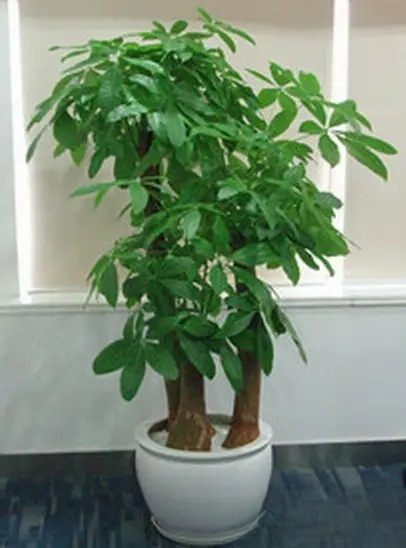
25. Plant name: Fortune Tree
Other names: Gua Li, Central American Kapok
Family: Bombaxceae, Castanea
Morphological characteristics: small evergreen tree with palmate leaves, 7 to 11 leaflets, oblong or obovate. Beautiful plant shape, bright green leaves, hammer-shaped trunk. Very vigorous. Mature plants outdoors bloom and bear fruit in spring, summer and autumn.
Cultivation value: Potted plants are suitable for home decoration and beautification.
Growth habits: It likes high temperature and high humidity environment, has poor cold resistance, and seedlings should avoid frost. It likes fertile, loose, breathable and water-retaining sandy loam, likes acidic soil, and avoids alkaline soil or heavy clay soil; it is relatively resistant to water and humidity, and slightly resistant to drought; it likes light, but has strong shade tolerance.
Cultivation techniques: Watering should follow the principle of watering when the soil is dry and wet. In spring and autumn, watering frequency should be controlled according to the weather conditions, such as whether the soil is sunny or rainy, dry or wet. Generally, water once a day. When the temperature exceeds 35℃, water at least twice a day. Fertilize twice a month during the growing season. For the new leaves, pay attention to spraying water to maintain a high environmental humidity to facilitate their growth. Water once every 5 to 7 days in winter, and ensure sufficient light.
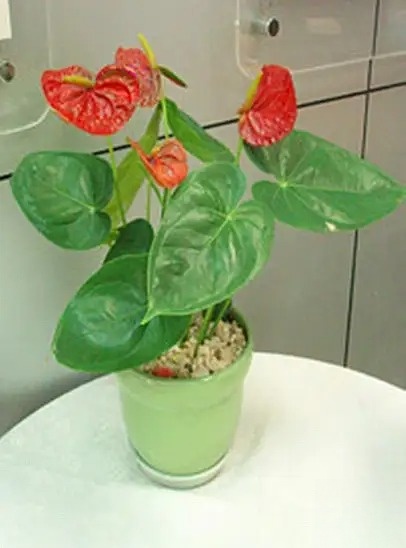
26. Plant name: Anthurium
Other names: Anthurium, Anthurium, Anthurium, Red Goose Palm
Family: Araceae, Anthurium
Morphological characteristics: Anthurium is a perennial evergreen herbaceous flower; its plant height is generally 50-80cm; it has fleshy roots and no stems, and the leaves grow from the rhizomes, have long petioles, are solitary, heart-shaped, bright green, and have sunken veins; the flowers are axillary, the spathes are waxy, round to oval, bright red, orange-red, or white, and the inflorescence is cylindrical and upright; it blooms in all seasons.
Cultivation value: Its flowers are unique, with spathes, bright and gorgeous colors, and rich colors. It is a world-famous precious flower.
Growth habits: It likes warmth, shade and humidity, avoids heat and direct sunlight. Its roots are aerial, so it requires good ventilation.
Cultivation technology: The optimum temperature for the growth of Anthurium is 18℃ ~ 28℃. In spring and autumn, it is generally watered once every 3 days. If the temperature is high, it can be watered once every 2-3 days depending on the dryness and wetness of the substrate in the pot. In summer, it can be watered once every 2 days, and watered once more when the temperature is high. In winter, it is generally watered once every 5-7 days. Anthurium requires higher air humidity for growth, which should generally not be lower than 50%.
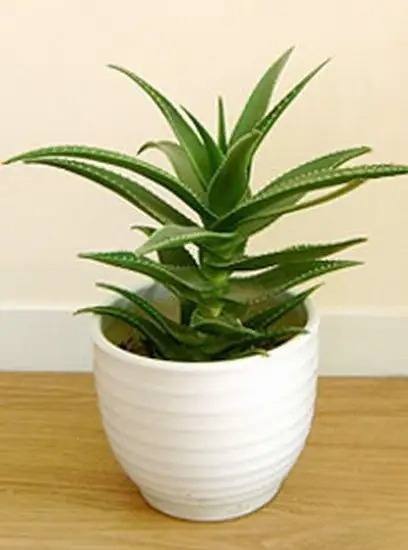
27. Plant name: Aloe
Other names: Lu Hui, Ne Hui, Xiang Dan, Nu Hui
Family: Aloe, Aloe
Morphological characteristics: Evergreen, fleshy herb; leaves grow in clusters, in a set or on the top of the stem, often lanceolate or short and wide, with sharp tooth-like thorns on the edges; inflorescences are umbel, racemose, spike-shaped, conical, etc., red, yellow or with red spots, with six petals and six pistils. The base of the perianth is often connected to form a tube.
Cultivation value: ornamental, medicinal and edible
Growth habits: likes warm, dry and semi-shady environment; not cold-resistant, afraid of high temperature and humidity, avoid strong sunlight.
Cultivation technology: The most suitable growth temperature for aloe vera is 15-20 degrees Celsius, and the minimum temperature cannot be lower than 2 degrees Celsius; potted aloe vera should be kept dry and moist, and never watered excessively; in summer, the temperature is high and the evaporation is large, so it is generally necessary to water once every 2 to 3 days, and the leaves can be sprayed with water in the morning and evening. In spring and autumn, keep the soil dry and water less. In winter, water once a month.
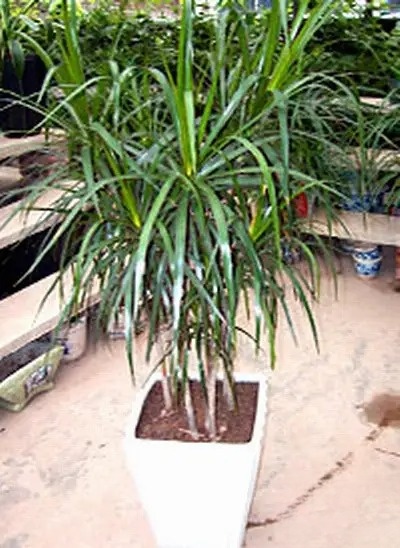
28. Plant name: Pteris serrata
Family: Liliaceae
Morphological characteristics: The plant height can reach 4 meters, sometimes branched, with upright stems; the leaves are broad linear, clustered, 30 to 40 cm long, 5 to 10 cm wide, oblong or lanceolate, with pointed tips and gradually pointed bases, and the leaves are all green; it is mainly used for viewing leaves and is a foliage plant.
Growth habit: Shade-tolerant, likes high temperature and humidity, should be kept warm and sheltered from the wind in winter
Cultivation techniques: Fertile loam or humus soil is preferred, with good drainage; place in a sunny indoor location, avoiding direct sunlight in summer; too strong or too dark light will cause the leaves to lose color and turn green, and too dark an environment will cause the leaves on the lower part of the stem to fall off; watering should be based on the principle of wet rather than dry, reduce watering in winter, and it is best to let it dormant.
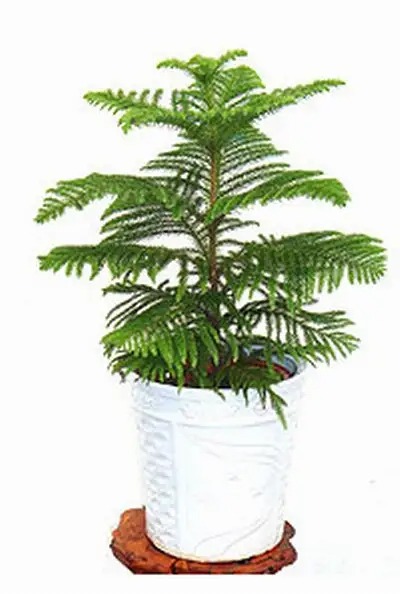
29. Plant name: Araucaria
Family: Araucariaceae, Araucaria
Morphological characteristics: Evergreen tall tree; can be used as a large potted plant, up to about 2 meters high. The crown of the young tree is spire-shaped; the large branches are flat or oblique, and the lateral branches are densely drooping and arranged in a nearly pinnate shape; the leaves on the young tree and the side branches are awl-shaped, needle-shaped or triangular, slightly quadrangular, 7 to 20 cm long, and arranged loosely and spread out.
Cultivation value: Seedling potted plants are suitable for embellishment of general living rooms, corridors, and study rooms; they can also be used to arrange various forms of venues and exhibition halls.
Growth habits: likes warm climate, fresh and moist air, soft and sufficient light, is not cold-resistant and avoids drought.
Cultivation techniques: Water moderately at ordinary times, water frequently during the growing season, 2 to 3 times a week, with a penetration depth of 10 to 15 cm; as the seedlings grow, water less frequently, always keep the potting soil and surrounding environment moist, and prevent drought and waterlogging; during hot and dry seasons, often spray water or mist on the leaves and the surrounding environment to increase air humidity and keep the soil moist.
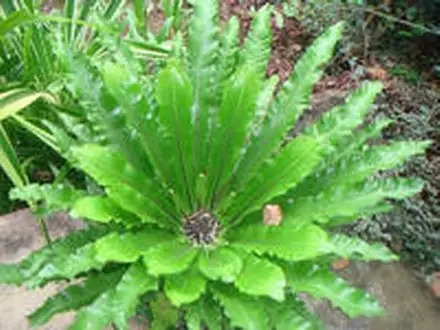
30. Plant name: Bird's nest fern
Other names: nest fern, mountain fern, crown fern
Family: Aspleniaceae, Pteris
Morphological characteristics: Bird's nest fern is a medium-sized epiphytic fern with a funnel-shaped or bird's nest-shaped plant, 60-120 cm tall; the rhizome is short and upright, with a thick petiole and densely covered with large clusters of spongy fibrous roots; the leaves are clustered and radially arranged at the top of the rhizome, hollow like a nest-shaped structure; the leathery leaves are broad-lanceolate, about 1 meter long, 9-15 cm wide in the middle, smooth on both sides, and the veins on both sides are slightly raised.
Cultivation value: Bird's nest fern is a larger shade-loving foliage plant.
Growth habits: likes high temperature and humidity, and cannot tolerate strong light.
Cultivation techniques: Peat soil or leaf humus is the best soil for potted bird's nest fern. The suitable growth temperature is 22-27℃. It should be placed in a bright place indoors and not in the dark for a long time. In the hot and humid summer, new leaves grow vigorously and need to be sprayed with water. Spray the leaves thoroughly as the leaves grow larger. Be sure to water the pot thoroughly when watering. Be careful not to accumulate water in the pot.
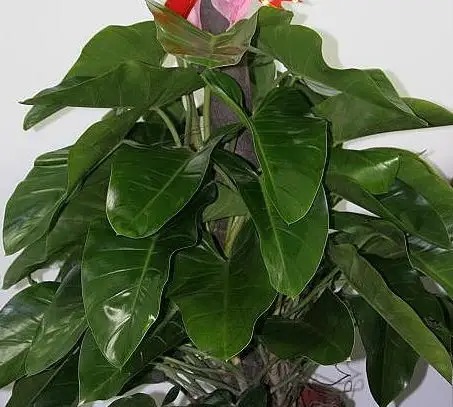
31. Plant name: Philodendron chinense
Other names: Fiddle-leaf philodendron, Fiddle-leaf vine, Split-leaf philodendron
Family: Araceae Philodendron
Morphological characteristics: It is a perennial herb. The stem is creeping and woody, with many aerial roots that can grow attached to other things. The leaves are expanded at the base, narrow in the middle, violin-shaped, leathery, dark green, and shiny.
Cultivation value: suitable for indoor and hall decoration.
Growth habits: likes high temperature and high humidity environment, not drought-tolerant, strong shade tolerance, likes fertile, well-drained slightly acidic sandy loam. Not cold-tolerant, avoid strong sun exposure.
Cultivation technology: Mostly used for potted climbing planting, stand a lightweight corrosion-resistant wooden stick with a diameter of 5-8 cm in the center of the pot, about 80-120 cm high, and wrap it tightly with palm skin; water the pot and the palm skin frequently during the growing season, and spray water on the leaves and the surrounding area frequently to increase the air humidity; apply a thin organic liquid fertilizer once every half a month or so; control water and fertilizer in winter to prevent cold.
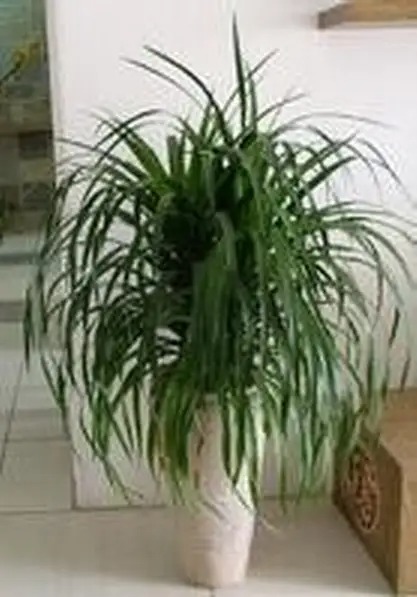
32. Plant name: Millennium wood
Family: Agavaceae
Morphological characteristics: evergreen shrub; the stem is round and straight, the leaves are slender, the new leaves extend upward, and the old leaves hang down; the leaves are green in the middle and have purple-red stripes on the edges.
Cultivation value: The leaves and roots can absorb xylene, toluene, trichloroethylene, benzene and formaldehyde, and decompose them into non-toxic substances.
Growth habits: It likes high temperature and humidity, is also drought-resistant and shade-tolerant, does not require much sunlight, and is easy to grow in water.
Cultivation technology: Generally, it is best to keep the relative humidity of the air at around 80%, especially in summer and autumn. You can often spray some soft water mist on the leaves; it can be placed in a bright or sunless place indoors. If it is placed indoors for a long time, it is best to expose it to the sun once a week.
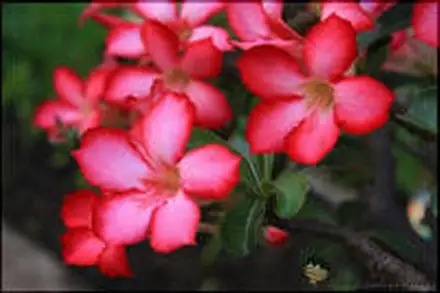
33. Plant name: Desert Rose
Other name: Tianbao flower
Family: Apocynaceae, Tianbaohua
Morphological characteristics: The desert rose flower is shaped like a small trumpet, rose red, with umbels in clusters of three or five, brilliant like brocade, and blooms continuously throughout the four seasons; the leaves are single and alternate, obovate, with acute apex, 8 cm to 10 cm long, 2 cm to 4 cm wide, leathery, shiny, dark green on the belly, and gray-green on the back.
Growth habits: Likes high temperature, dry and sunny environment; resistant to heat, not cold, resistant to drought, and avoids water and humidity.
Cultivation techniques: Potted plants need sufficient sunlight and good drainage; it should be dry rather than wet during the growing season. Water once a day in the hot summer, and once every 2 to 3 days at other times; fertilize 2 to 3 times throughout the year; leaves fall normally during the dry dormancy period in winter; cultivate indoors and require sufficient light.
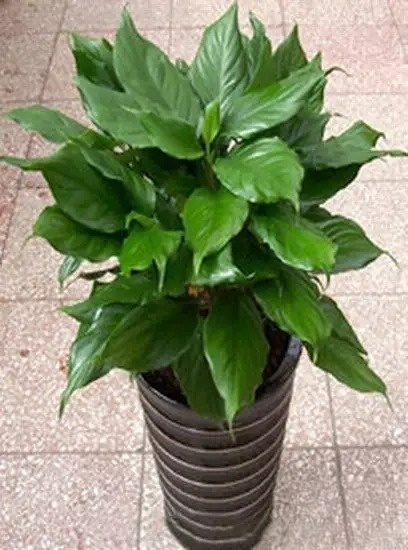
34. Plant name: Dieffenbachia
Other name: Daifenye
Family: Araceae, Dieffenbachia
Morphological characteristics: Evergreen shrubby herb with thick and fleshy stems, plant height can reach 1.5 meters; leaves are large and shiny, borne on the upper part of the stem, elliptical-ovate or broadly lanceolate, gradually pointed at the tip, entire, 20-50 cm long, 5-15 cm wide; the broad leaves are dark green on both sides, inlaid with dense, irregular spots, stripes or patches of different colors such as white, milky white, light yellow, etc.
Cultivation value: Young plants in small pots can be placed on desks or windowsills for viewing. Medium-sized pots can be placed in the corners of the living room or next to the sofa as decoration.
Growth habits: likes warm, humid and semi-shady environment; not cold-resistant, afraid of drought, avoid strong sunlight exposure.
Cultivation technology: Variegated Dieffenbachia likes moisture and is afraid of dryness. The potting soil should be kept moist. It should be watered sufficiently during the growing period, and water should be sprayed around and on the plants. The soil moisture is best when it is dry and wet in order. Water more in summer and control watering in winter, otherwise the potting soil will be too wet and the roots will easily rot.
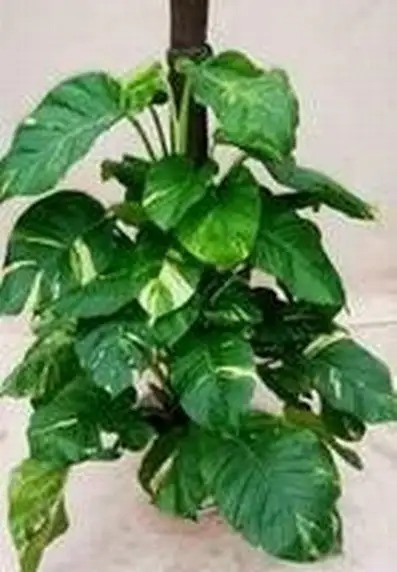
35. Plant name: Golden Pothos
Family: Araceae, Araceae
Morphological characteristics: Perennial climbing plant with aerial roots, able to grow on tree trunks, walls, etc.; stems with grooves between nodes; leaves leathery, oblong, heart-shaped at base, short pointed at end, often pinnate-shaped; young leaves small, mature leaves 20-60cm long, 20-50cm wide, the stems and leaves grow larger as they grow upwards, while those hanging downwards become smaller; the front of the leaves is shiny, with light yellow spots and stripes, and does not bloom.
Cultivation value: It can purify the air and remove formaldehyde, benzene, carbon monoxide and nicotine.
Growth habits: It likes warm and humid climate, semi-shade and fertile and loose soil; it is sensitive to light and afraid of direct sunlight, but if the light is weak, the colorful stripes will dim and gradually disappear.
Cultivation techniques: The potting soil should always be kept moist, preferably with slow drip irrigation from the top of the column; avoid drought in summer, there should be sufficient water, and water should be sprayed on the leaves frequently; prevent waterlogging in winter, and the potting soil should not be wet for a long time; change the placement direction constantly so that the green leaves receive even light and keep the plant symmetrical and plump.
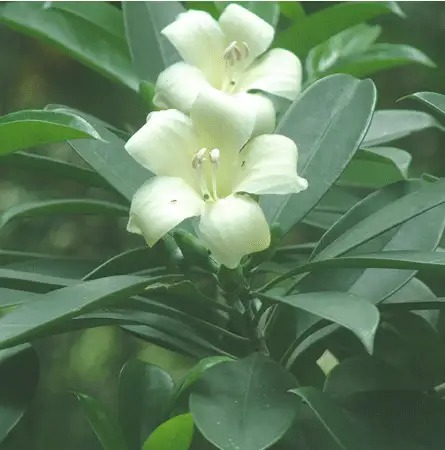
36. Plant name: Ligusticum chuanxiong
Other names: African jasmine, Chinese jasmine
Family: Rosaceae, Ligustrum
Morphological characteristics: Evergreen tree or shrub, sometimes climbing; leaves opposite, slightly fleshy, elliptical or obovate-elliptical, 5-10 cm long, with unclear lateral veins; flowers solitary or in dichasing cymes; corolla white, fragrant; fruit nearly spherical, light green.
Cultivation value: The flowering period is very long, it blooms in winter and summer, and it blooms most brilliantly in spring and summer; in the early morning or at dusk, the faint fragrance is refreshing.
Growth habits: It likes sunlight, is shade-tolerant, and has strong cold-resistance. It remains lush and green all year round in the southern tropical region. It has no strict requirements on soil and has strong adaptability.
Cultivation techniques: Water in spring and autumn to keep the soil moist; be careful to prevent waterlogging during the rainy season; in summer, spray water once in the morning and afternoon to increase humidity and reduce temperature; in winter, keep the soil slightly moist, and spray a proper amount of water on the leaves when the temperature is relatively high around noon; it requires sufficient scattered light, or place it near the window, and should not be too dark, otherwise the leaves will lose their green color, turn yellow, or fall off.
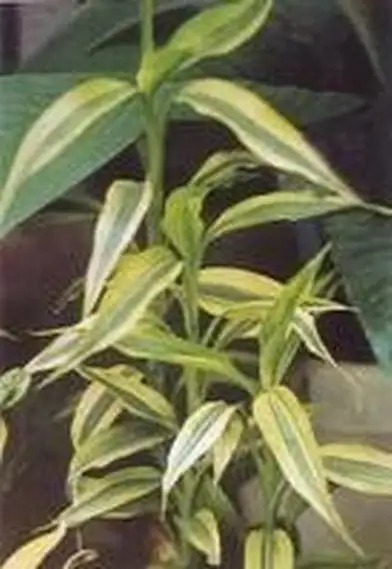
37. Plant name: Golden-edged lucky bamboo
Other name: Bordered bamboo banana
Family: Agavaceae, Dracaena
Morphological characteristics: Perennial evergreen herb, the plant height can reach 1.5 to 2.5 meters or more, with thick stems and leaves. Its varieties include green leaves, green leaves with white edges (called silver edges), green leaves with yellow edges (called gold edges), and green leaves with silver core (called silver core).
Cultivation value: Suitable for home greening decoration, arranged on windowsills, balconies and desks, and can also be decorated in rows in the hall.
Growth habits: Likes high temperature, humidity and sunny environment, not cold-resistant, resistant to pruning, avoids direct sunlight in summer, loose sandy loam is preferred.
Cultivation techniques: Keep the potting soil moist during the growing season, spray water to increase air humidity, fertilize once every half month, change the pot in April-May every year, and prune the whole plant to allow new branches to sprout; it grows vigorously in summer, so provide appropriate shade and water frequently to prevent the potting soil from drying out.
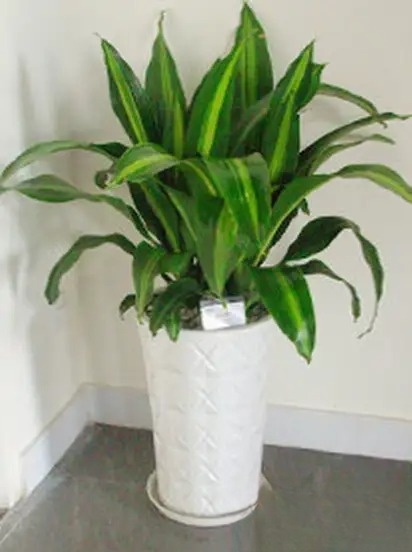
38. Plant name: Golden Heart Yemen Iron
Other names: Golden Heart Brazilian Iron, Brazilian Millennium Wood
Family: Liliaceae, Dracaena
Morphological characteristics: The potted plant is 50 cm to 150 cm high and has branches; the leaves are clustered at the top of the stem, 40 cm to 90 cm long, 6 cm to 10 cm wide, curved in an arch shape, bright green and shiny; the flowers are small and inconspicuous, and fragrant.
Cultivation value: It can effectively absorb harmful gases such as formaldehyde and benzene in the room.
Growth habits: It likes high temperature, high humidity and good ventilation environment. The suitable growth temperature is 20-30℃. It likes light and is also shade-tolerant. It is afraid of the scorching sun and avoids dryness and drought. It likes loose and well-drained sandy soil.
Cultivation technology: The potting soil for cultivation should have good drainage and ventilation. When watering, wait until the soil is 70% dry before watering. During the growing season, spray water frequently to increase the surrounding humidity. If a single plant is placed indoors for viewing, in addition to spraying water, you can also place the flowerpot on a sand tray to create a humid microclimate. During the rainy season, prevent water accumulation in the pot.
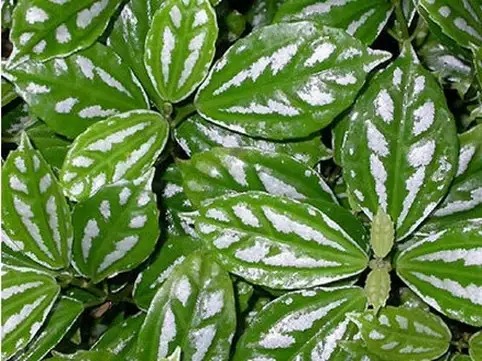
39. Plant name: Pilea
Other names: transparent grass, variegated nettle, white snow grass, aluminum leaf grass
Family: Urticaceae, Pilea
Morphological characteristics: Perennial herb, plant height 30-50 cm, fleshy above-ground stem, swollen internodes, simple leaves opposite, elliptic-ovate, gradually pointed at the apex, sparsely serrated in the upper half of the leaf margin, entire in the lower half, with white spots on both sides of the main vein on the leaf surface.
Cultivation value: It can be displayed in the study or bedroom, which is elegant and pleasant; it also has medicinal value.
Growth habits: relatively cold-resistant, likes warm and humid climate, afraid of sunlight exposure, not demanding on soil, can tolerate weak alkali, relatively resistant to water and humidity, not drought-resistant.
Cultivation techniques: Fertilizer and water management should follow the principles of moisture management. It is better to keep the potting soil dry but not cracked, moist but not wet. In summer, spray water on the leaves frequently to keep them clean and shiny. Spray less water on the leaves in winter. It is more shade-tolerant, avoids strong sunlight, and likes scattered light.
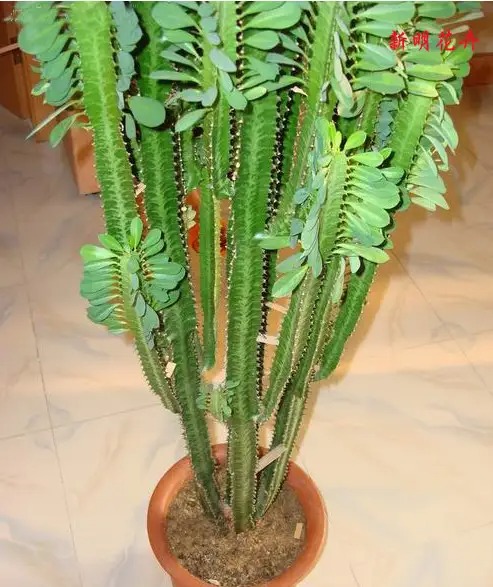
40. Plant name: Dragon bone
Aliases: Triangle Overlord Whip, Caiyun Pavilion, Dragon Bone Pillar
Family:Euphorbiaceae, Euphorbia
Morphological characteristics: The dragon bone flower grows robustly and can reach a height of 2 to 3 meters. The plant is shrub-like with many and dense branches, tender fleshy leaves, and leaves 2 to 4 cm long. There is a short main trunk at the base, which is whorled around the main trunk, with 3 to 4 edges, serrated edges, and hard short thorns that grow vertically upward.
Growth habits: Drought-resistant, sun-resistant, not cold-resistant, not demanding on soil, and can grow well in general culture soil.
Cultivation techniques: Watering should be appropriate. If the soil in the pot is too wet for a long time, it will cause root rot. During the winter dormancy period, water it once every 1 to 2 months and it will not dry out to death. It needs to be placed in a sunny place to get more sunlight, and the pot should be rotated after a certain period of time.
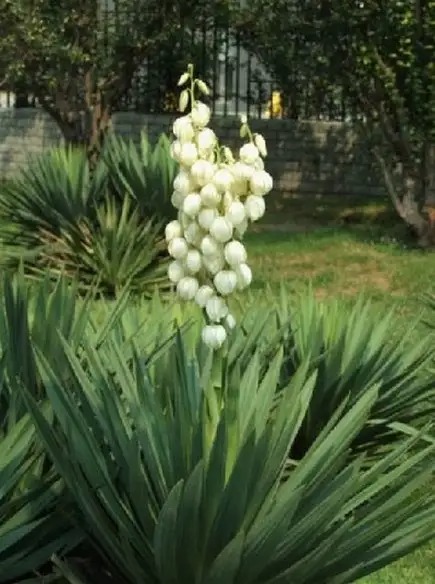
Other names: Soft-leaved yucca, Hairy-edge yucca
Family: Agavaceae, Yucca
Morphological characteristics: Evergreen shrub, short stem, leaves clustered at the base, arranged in a spiral shape, hard and thick leaves, 50-80 cm long, 4-7 cm wide, with hard spikes on the top, wrinkled leaves, dark green with a small amount of white powder, hard, straight and oblique, smooth leaf margins, old leaves with a few filaments.
Cultivation value: Yucca has strong resistance and absorption capacity to harmful gases such as sulfur dioxide, hydrogen fluoride, chlorine, ammonia, etc.; Yucca also has a strong ability to absorb hydrogen fluoride. In addition, Yucca has a certain resistance to ammonia, ethylene, etc.
Growth habits: It is a tropical plant with a strong nature and is easy to survive. It likes an environment with plenty of sunlight and good ventilation. It is also extremely cold-resistant. Yucca has a well-developed root system and strong vitality. Its leaves have a thick cuticle and wax layer, which can reduce evaporation, so it has a particularly strong drought resistance.
Cultivation technology: Loose and fertile sandy loam is the best soil for cultivation, and drainage is required. Full sun or half sun can be used during the growing season from late spring to summer, and fertilizer should be applied once every 1 to 2 months. For adult plants, cut off the aging leaves at the bottom at any time to promote growth and sprout new leaves. The culture medium should not be moist for a long time.
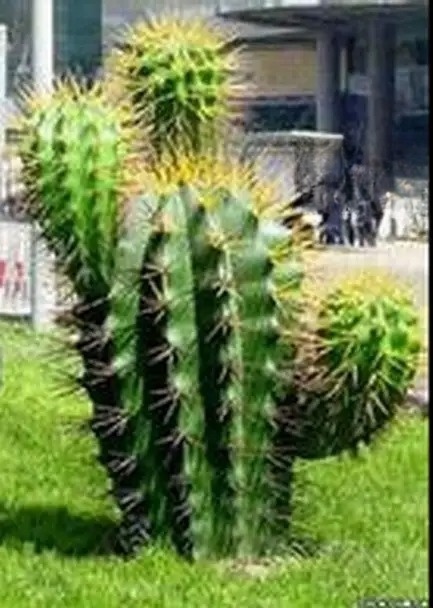
42. Plant name: Cactus
Other names: Immortal Palm, Overlord Tree, Flame, Fire Palm, Jade Hibiscus
Family: Cactaceae, Cactus
Morphological characteristics: Perennial evergreen herb, shrub-like, 2-3m high, cylindrical stem, oblong, flat, fleshy nodes, many branches at the top; sparse areoles, short, yellow-brown thorns; 2-3 flowers are borne on the areoles at the top of the nodes, the perianth is short funnel-shaped, yellow. Flowering period is June to July, and the berries are dark red.
Cultivation value: ornamental, edible, medicinal
Growth habits: likes sufficient sunlight and warm, ventilated environment, slightly cold-resistant, drought-resistant, and avoids waterlogging. It has no strict requirements on soil and has strong adaptability.
Cultivation techniques: The potting soil should be made of equal parts of coarse sand, garden soil, and leaf mold; give direct sunlight after it takes root, water only when the potting soil is dry, and apply fertilizer once every two months; it can withstand direct sunlight in summer and the wintering temperature is above 0℃.
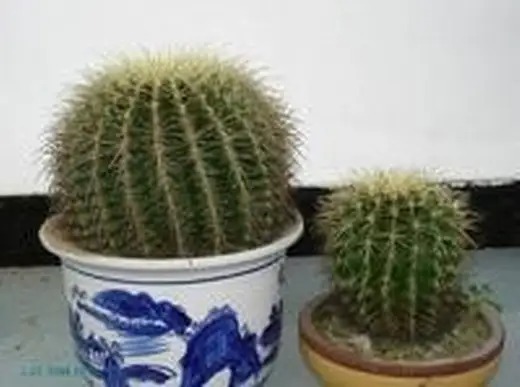
43. Plant name: Cactus
Other names: Grass ball, Changsheng ball
Family: Cactaceae, Opuntia
Morphological characteristics: Perennial fleshy herb; stem is spherical or elliptical, up to 25 cm high, green, with several longitudinal ridges on the sphere, densely covered with yellow-green thorns of varying lengths, radiating; flowers are borne among the longitudinal thorns, silvery white or pink, long trumpet-shaped, up to 20 cm long, with scales outside the trumpet and long hairs inside the scales.
Cultivation value: anti-radiation, air purification, edible, medicinal
Growth habits: likes dryness, tolerates drought, likes high temperature, cannot tolerate moisture or cold.
Cultivation techniques: require sufficient sunlight, but not strong sunlight in the summer; the best time for watering is early morning in summer, before noon on a sunny day in winter, and in the morning and evening in spring and autumn; generally do not water from the top; summer is the growing season for cacti, with high temperatures and high water requirements, so they must be watered sufficiently; watering should be restrained during the winter dormancy period to keep the potting soil from being too dry.
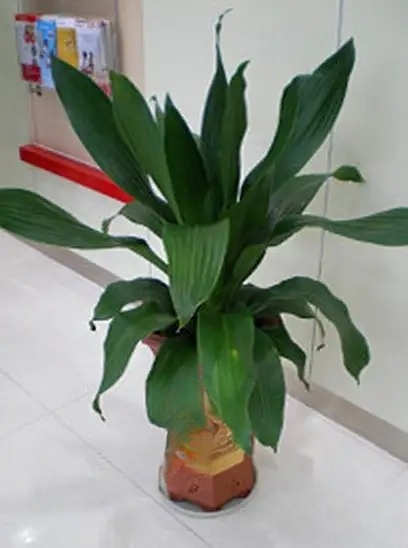
44. Plant name: Yemen Iron
Family: Liliaceae, Dracaena
Cultivation value: ornamental value
Growth habits: likes warm, humid and well-ventilated environment, likes semi-shade and tolerates shade
Cultivation techniques: Use well-drained leaf mold as the soil, preferably slightly acidic; place it on the windowsill in direct sunlight in winter, and in scattered light indoors in other seasons; fertilizer is mainly nitrogen fertilizer, and pay attention to the combination of fertilization and watering to prevent root burn; water once a week during the growing season, and water when dry; spray water on the leaves once in the morning and evening during the high temperature in summer.
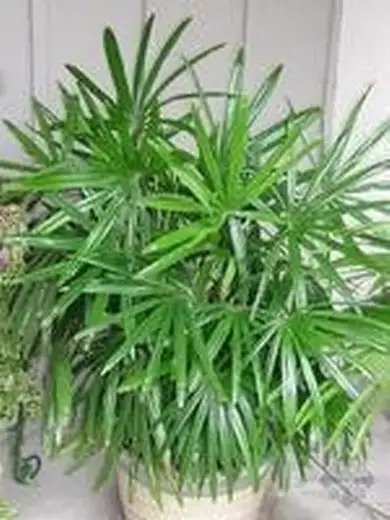
45. Plant name: Bamboo
Other names: Guanyin bamboo, tendon bamboo, palm bamboo, dwarf palm bamboo
Family: Arecaceae, Palmaceae:
Morphological characteristics: a bushy shrub with an upright stem, 1-3 meters high; the stem is as slender as a finger, unbranched, with leaf nodes; the leaves are clustered at the top of the stem, palm-shaped, deeply lobed almost to the base, with 3-12 lobes, 20-25 cm long and 1-2 cm wide; the petiole is slender, about 8-20 cm; the spadix is axillary, the flowers are small, light yellow, very numerous, unisexual, and dioecious. :
Cultivation value: ornamental value, can be used as medicine
Growth habits: like warm, humid and well-ventilated semi-shady environment, not tolerant to waterlogging, extremely tolerant to shade. Afraid of scorching sun, slightly tolerant to cold.
Cultivation techniques: The substrate for potted plants can be made from a mixture of equal amounts of leaf mold, garden soil, and river sand; the potting soil should be moist, rather than dry, but not waterlogged; reduce watering appropriately in autumn and winter; provide shade during the growing season, especially avoid exposure to the sun in summer; a well-ventilated environment is required.
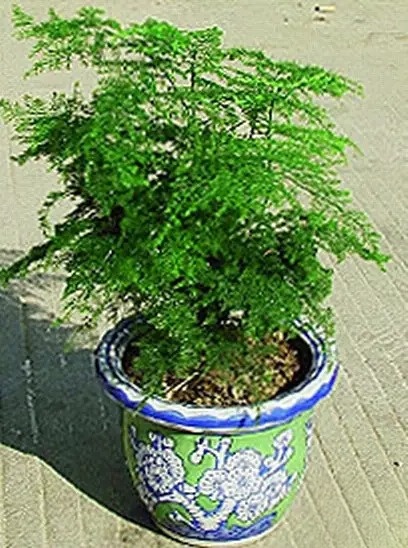
46. Plant name: Asparagus fern
Other names: Cloud pine, Asparagus cochinchinensis, Cloud bamboo
Family: Liliaceae Asparagus
Morphological characteristics: The roots of Asparagus fern are slightly fleshy, the stems are soft and tufted, and the elongated stems are climbing; the true leaves degenerate into scales, light brown, and grow at the base of the leaf-like branches; the leaf-like branches are slender and tufted, triangular and horizontally spread out like feathers; each leaf-like branch has 6 to 13 twigs, 3 to 6 mm long, green. The scales on the main stem are mostly thorn-like, like pine needles, delicate and beautiful.
Cultivation value: famous indoor foliage plant, can be used as medicine
Growth habits: It likes warm, humid and semi-shady environment, is not resistant to severe cold, drought, and avoids direct sunlight.
Cultivation techniques: In winter, spring and autumn, watering should be properly controlled. Generally, watering should be done when the surface of the potting soil is dry. You can also adopt alternating large and small watering, that is, after 3 to 5 small waterings, water it thoroughly once to keep the potting soil moist but not too much water. Watering should be done in the morning and evening in summer. Watering should be done when the potting soil is dry. Watering should be sufficient during the growth period, but not too much, otherwise the roots will rot easily. The water should penetrate into the soil quickly without water accumulation on the soil surface. Watering should be reduced after late autumn.
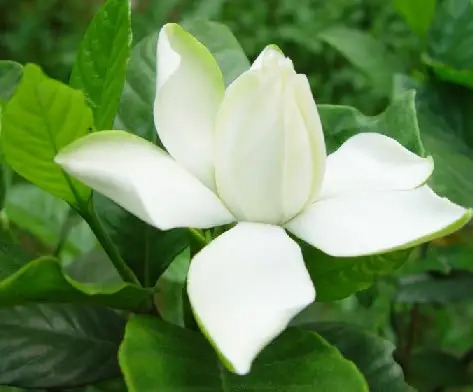
47. Plant name: Water hyacinthus
Other names: Mudan, fresh branch, Zhizi, Yuetao, Zhizi flower, gardenia flower, yellow gentian, gardenia, yellow gardenia, mountain yellow gardenia, jade lotus, white toad flower, Zen guest flower
Family: Rubiaceae, Gardenia
Morphological characteristics: Evergreen shrub or small tree, 100-200 cm high, most of the plants are relatively short; trunk gray, twigs green, leaves opposite or in whorls on the main branches, obovate-oblong, 5-14 cm long, glossy and full-line, flowers solitary at the top of branches or in leaf axils, white, strong fragrance; corolla high-footed saucer-shaped, 6-lobed, fleshy.
Cultivation value: Gardenia is resistant to sulfur dioxide and can absorb sulfur to purify the atmosphere. It can be used as medicine and is edible.
Growth habits: It likes warmth, humidity, sunlight, high air temperature and good ventilation. It is not cold-resistant, tolerates partial shade, and is afraid of waterlogging.
Cultivation techniques: Pay attention to watering during the seedling stage, keep the potting soil moist, and apply well-rotted thin fertilizer frequently; for potted gardenias, only water them with clean water after they bloom in August, and control the amount of watering; move them indoors before the Cold Dew in October and place them in a sunny place; strictly control watering in winter, but spray the leaves with clean water frequently; from May to July each year, when the vigorous growth period is about to stop, prune the plants to remove the tops to promote branching.
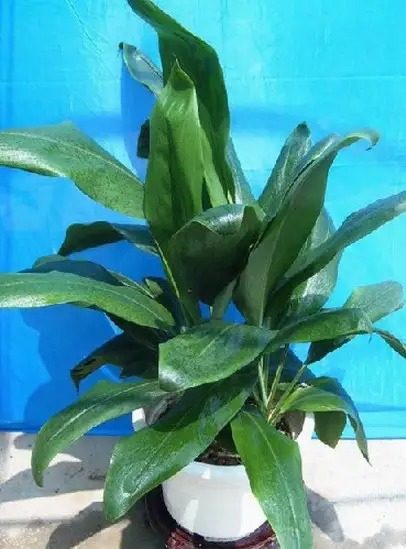
48. Plant name: Cordyline
Aliases: Red iron (red), blue iron (blue)
Family: Agavaceae, Cordyceps
Morphological characteristics: shrub-like, upright, 1 to 3 meters high. Stem thickness 1 to 3 cm, sometimes slightly branched. Leaves clustered at the upper end of the stem or branch, rectangular to rectangular lanceolate, 25 to 50 cm long, 5 to 10 cm wide, green or purple-red, petiole grooved, 10 to 30 cm long.
Cultivation value: ornamental value, can be used as medicine
Growth habits: Qing Tie likes light and semi-shady environment, is suitable for warm and humid climate, is not cold-resistant, and avoids saline-alkali land. It is best to plant it in fertile, moist and well-drained sandy loam.
Cultivation techniques: The potting soil must be kept moist during the growing period; lack of water can easily cause leaves to fall, but too much water or water accumulation in the pot can also cause leaves to fall or yellowing of leaf tips; spray water frequently during the growing period of stems and leaves, and an air humidity of 50% to 60% is more suitable.
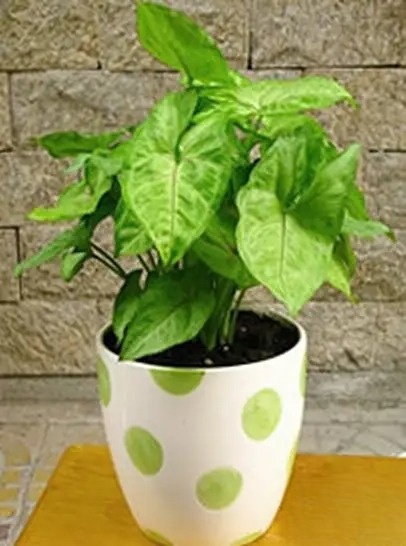
49. Plant name: White butterfly
Other names: Green Elf, White Spot Leaf, Syngonium, Arrow Leaf Taro
Family: Araceae, Syngonium
Morphological characteristics: Herbaceous foliage plants, leaves with long petioles, new leaves are arrow-shaped, old leaves are three-lobed or five-lobed palmate compound leaves, green white spots, short stems, leaves often grow in clusters, sometimes stems stretch into vines, and nodes often have aerial roots.
Cultivation value: indoor foliage plants
Growth habits: strong in nature, likes moisture, and has strong shade tolerance. It likes high temperature, humidity, and semi-shaded environment. It is afraid of scorching sun and drought, and avoids low temperature. It is not cold-resistant, afraid of scorching sun and drought.
Cultivation techniques: Topdressing is applied once every 1 to 2 weeks during the growing season. It prefers a warm, humid and semi-shady environment. The wintering temperature should be above 13°C. It is suitable for an environment with medium brightness indoors to semi-sunlight outdoors. It prefers warm and humid conditions. This plant has high requirements for water. The principle of keeping the water level in the bottle high rather than low should be followed for hydroponic cultivation throughout the year, and water should be sprayed frequently to keep the surrounding environment moist.
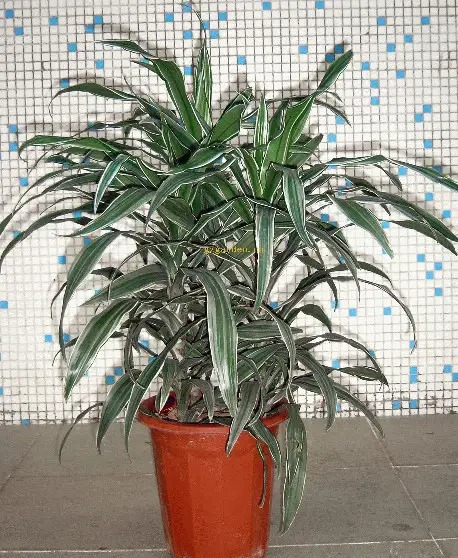
50. Plant name: Silver-edged iron
Other name: Dracaena fragrans
Family: Liliaceae, Dracaena
Morphological characteristics: Potted plants are usually less than 1.5 meters tall, sometimes branched. The leaves are clustered at the top of the stem, curved into an arch, with wavy edges, slightly blunt tips, bright green and shiny.
Cultivation value: A new generation of indoor ornamental plants that can remove harmful substances from the air.
Growth habits: It prefers high temperature, high humidity and semi-shaded environment.
Cultivation techniques: Water less often, at most once a week during the growing season. If the temperature can be kept low during the winter dormancy period, water once every 10-15 days. Direct sunlight will burn the leaves, so the flower pot should be 1-2 meters away from a south or southwest window. Apply liquid fertilizer for foliage plants once every 15 days. Spray water on the leaves (leaf surface, especially the back) every day. At the same time, place the flower pot on a moist gravel layer to remedy the excessive dry air in the room.
Indoor potted plants selection
